December 23, 2022
Part 3: Attempts to Impose Martial Law (May 20 – May 30)
May 20, 1989 – New York Times front page:
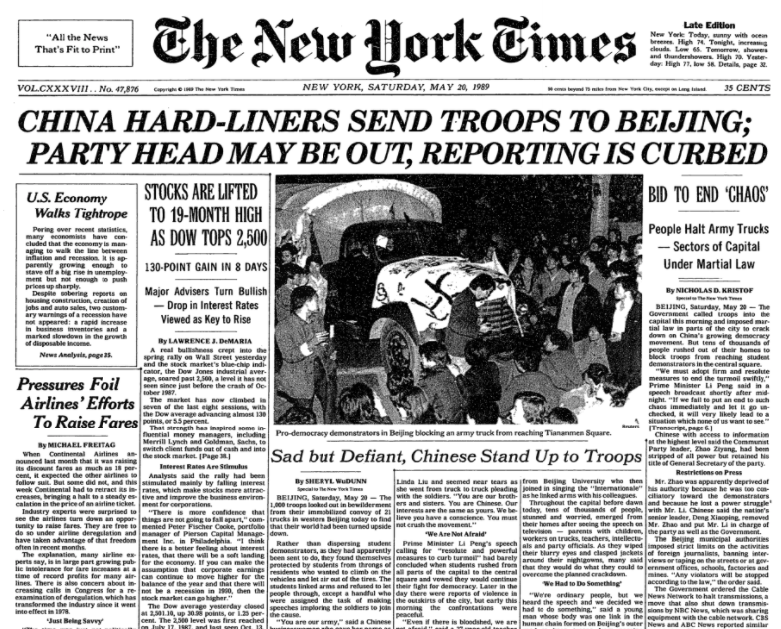
May 20, 1989 – In early morning hours, troops successfully sweep hunger strikers from Shanghai’s People’s Square.
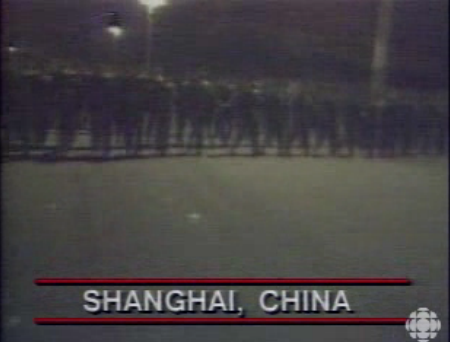
May 20, 1989 – Crowds of unarmed citizens block army troop convoys from entering Beijing to enforce martial law.
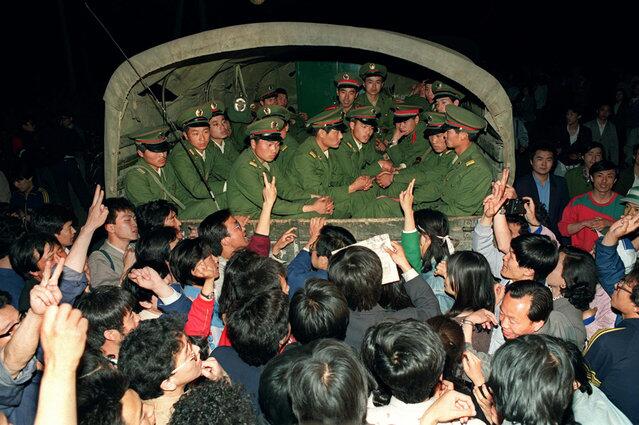
May 20, 1989 – Student reads list of protesters’ goals to army soldiers blocked by crowds from entering Beijing.
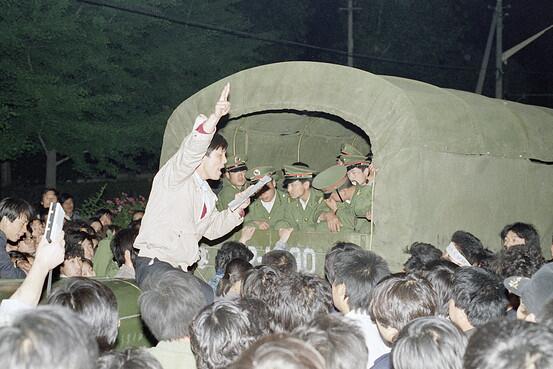
May 20, 1989 – By dawn, 2 million Beijing residents had taken to the streets to resist imposition of martial law.
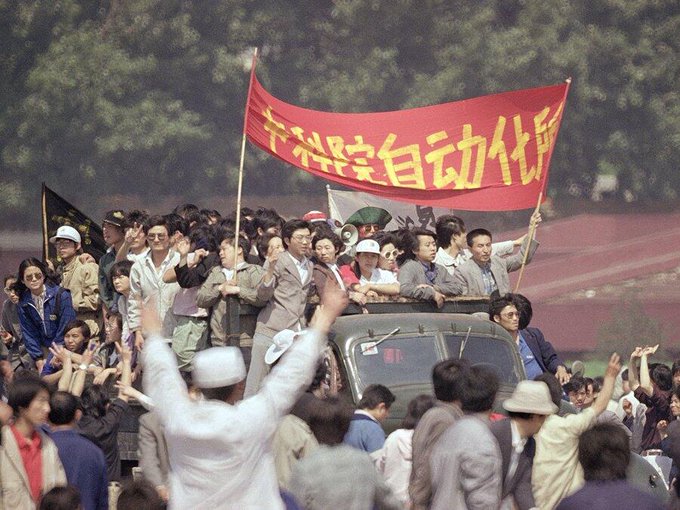
May 20, 1989 – Beijing residents build physical barricades to prevent troops from reaching Tiananmen Square.
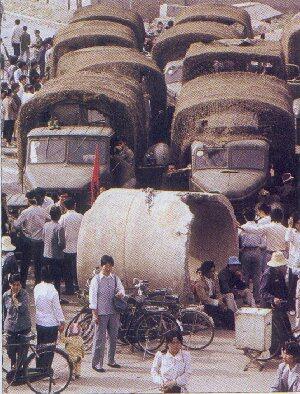
May 20, 1989 – Tianjin official: “I want stability for our country, but it must be … based on popular consent and satisfaction … not terror”
May 20, 1989 – Mother introduces her son to soldier on army truck blocked by crowds 8km west of Tiananmen Square.
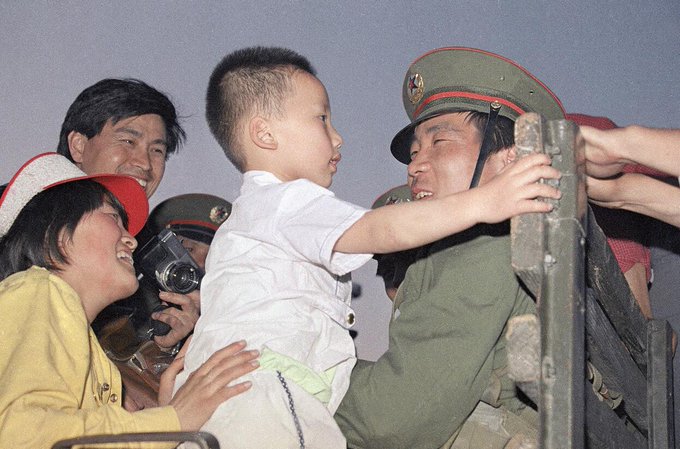
May 20, 1989 – ABC News anchor: “What is the potential for violence?” Reporter in Beijing: “I think it’s very great.”
May 20, 1989 – Military helicopter flies over student-occupied Tiananmen Square.
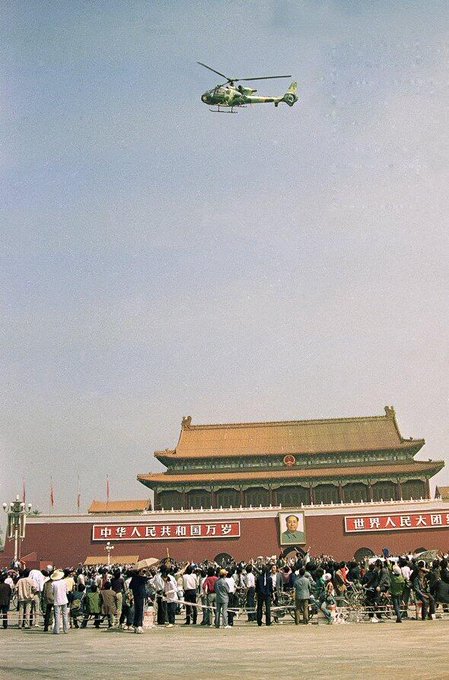
May 20, 1989 – New York Times: Thousands block army trucks from reaching center of Beijing; U.S. expresses concern.
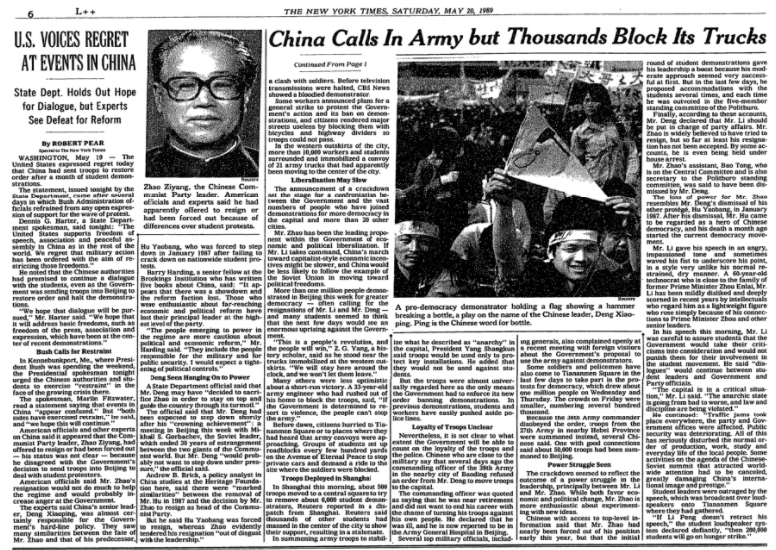
May 20, 1989 – New York Times: China orders end to TV broadcasts.
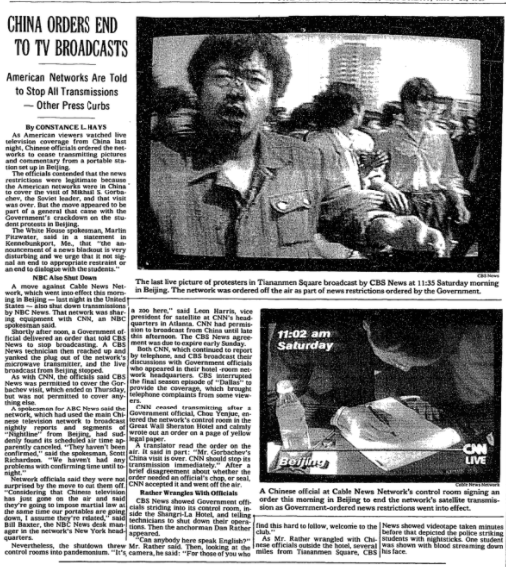
May 21, 1989 – Student protesters wave fists as five military helicopters buzz Tiananmen Square at dawn.
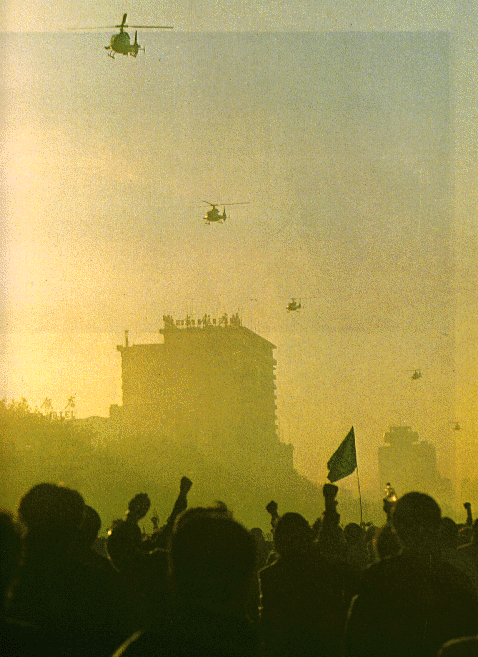
May 21, 1989 – Convoy of troops sent to impose martial law, stopped along road on the outskirts of Beijing.
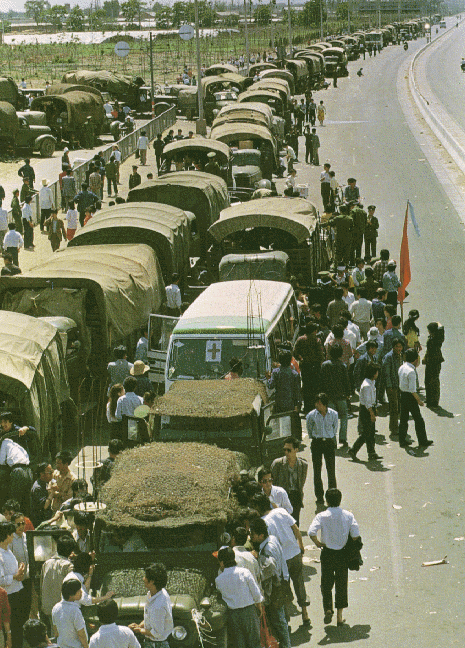
May 21, 1989 – Student protesters offer food and drink to soldiers whose convoy they stopped from entering Beijing.
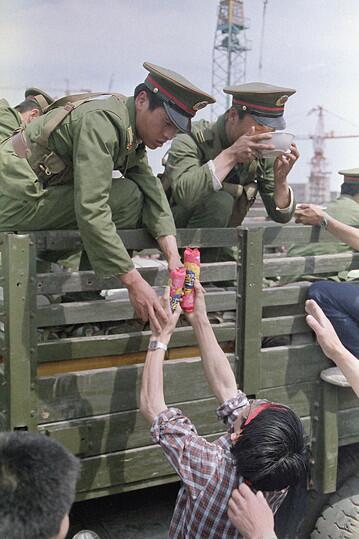
May 21, 1989 – Deng Xiaoping convenes top leaders (minus Zhao Ziyang) at his home in Zhongnanhai.
May 21, 1989 – Deng Xiaoping: “Martial law hasn’t restored order…the trouble just gets bigger and bigger, and now it’s out of hand.”
May 21, 1989 – Deng Xiaoping: “Let’s be clear: Our Party and state face a life-and-death crisis.”
May 21, 1989 – Deng Xiaoping: “Zhao Ziyang … bears undeniable responsibility … we’ve got to talk about the Zhao Ziyang problem.”
May 21, 1989 – New York Times: Changes made my Deng return to vex him.
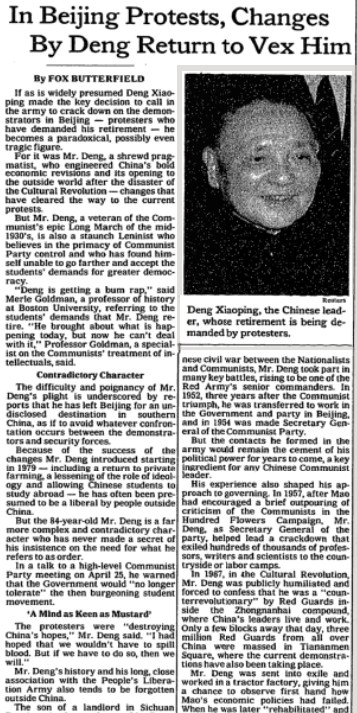
May 21, 1989 – New York Times: Soviet news agency reports on turmoil in China.

May 21, 1989 – Rose Tang in Tiananmen Square, morning after leading sit-in outside Zhongnanhai.
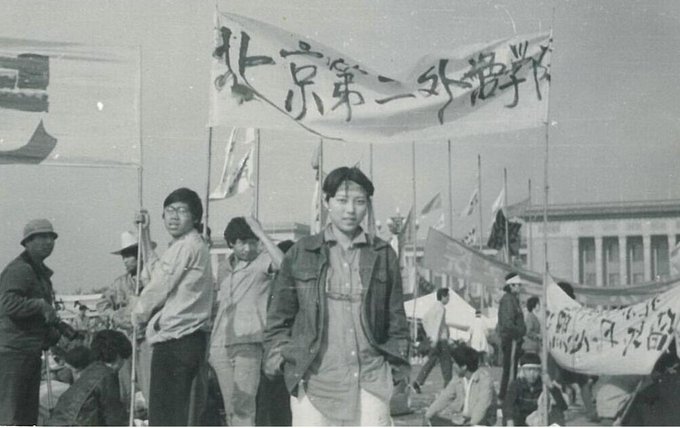
May 21, 1989 – Student leaders vote 32-14 to withdraw from Tiananmen Square, but later reverse decision as more people flood into the Square.
May 21, 1989 – New York Times: Diplomats say China is mired in crisis it could have averted.
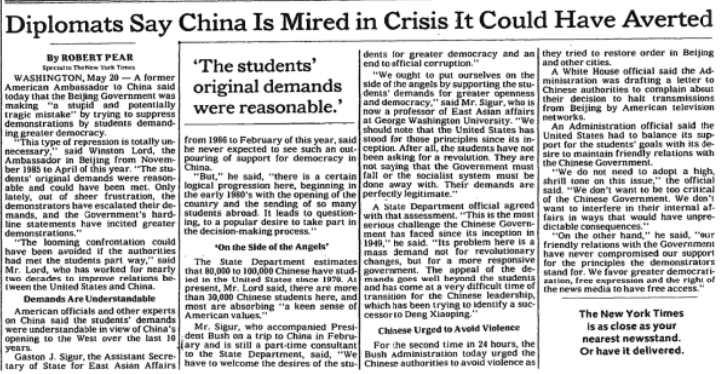
May 21, 1989 – New York Times: Protesters in British-ruled Hong Kong demonstrate against martial law in China.
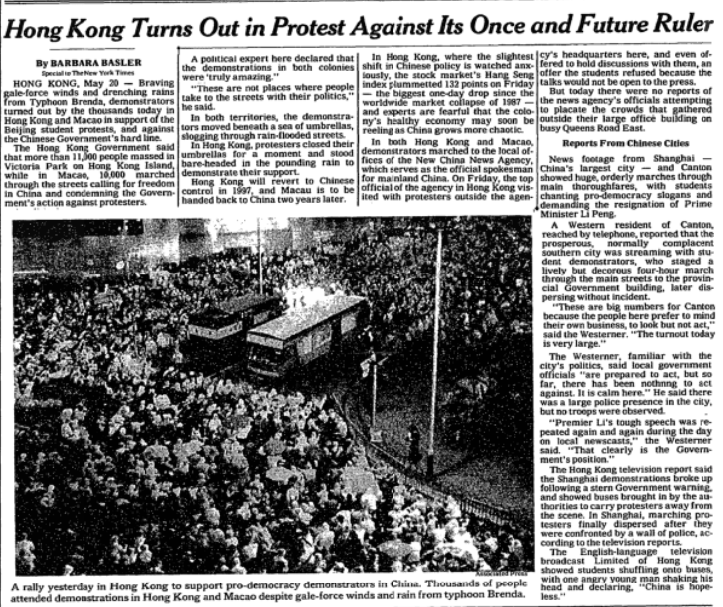
May 21, 1989 – New York Times: Thousands of Chinese in U.S. rally in support of protesters in China.
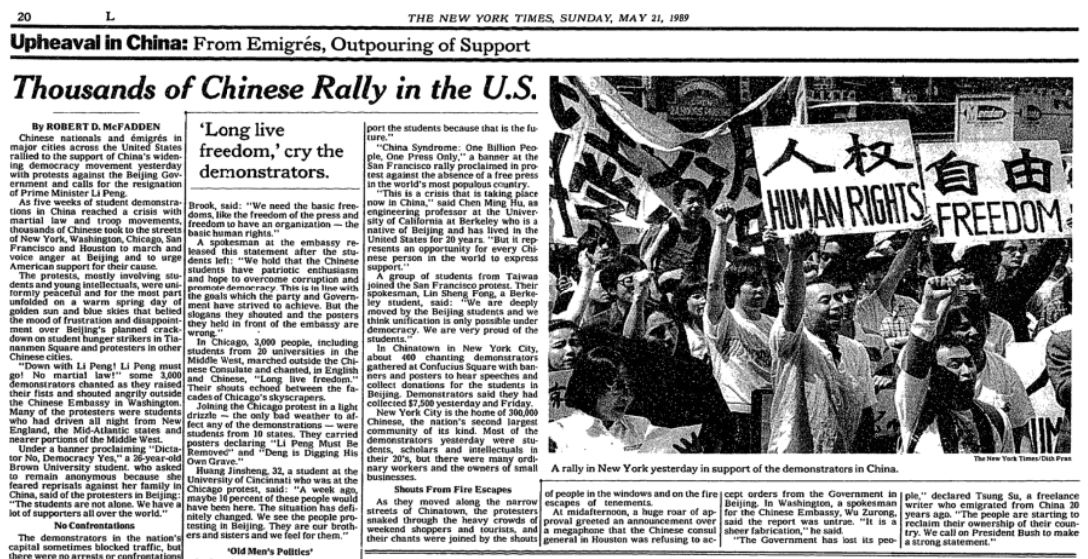
May 21, 1989 – New York Times: With imposition of martial law, China’s military faces new challenge.
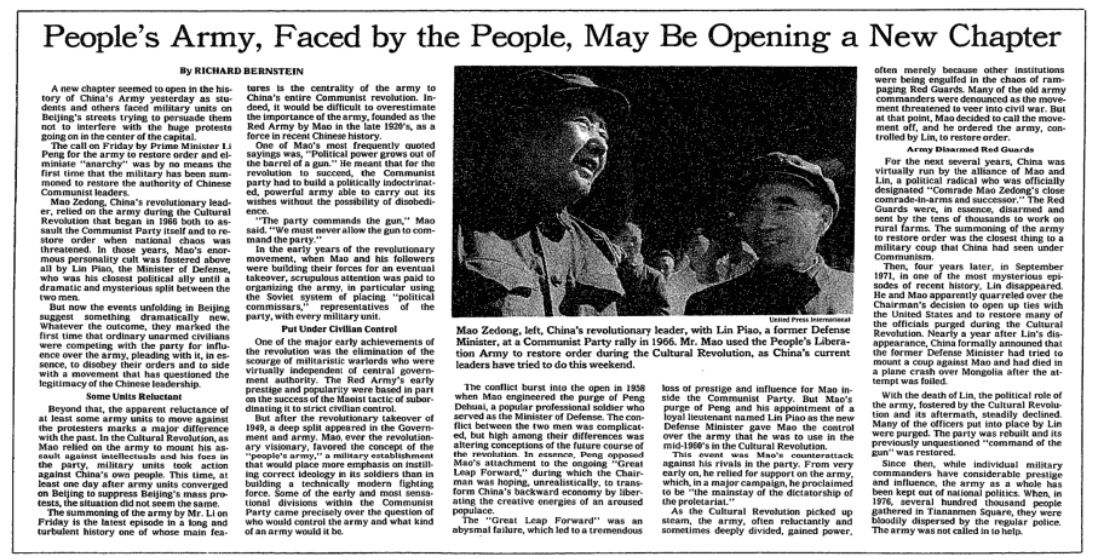
May 21, 1989 – New York Times: “Armed only with optimism, China’s people rise again”.
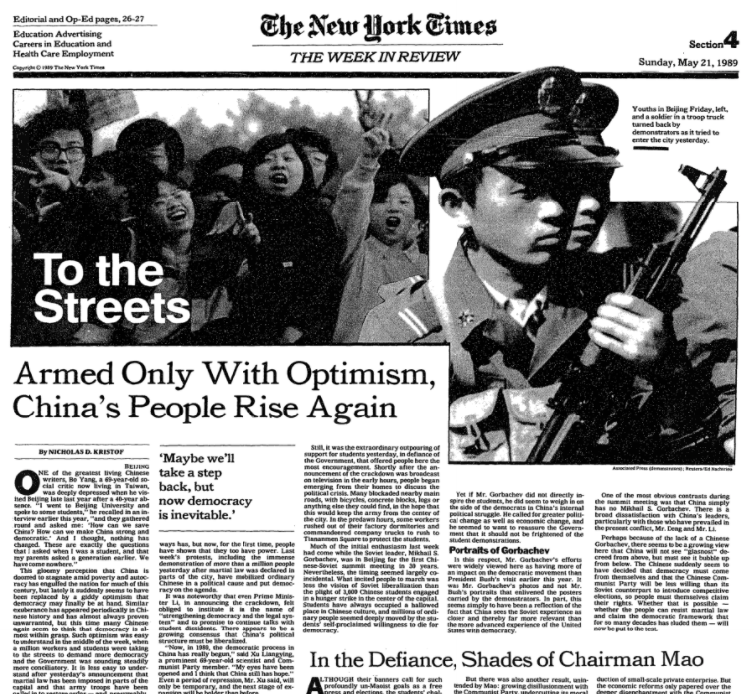
May 21, 1989 – New York Times: President Bush urges Chinese protesters to “stand up” for beliefs, but U.S. acts with “the upmost caution”.
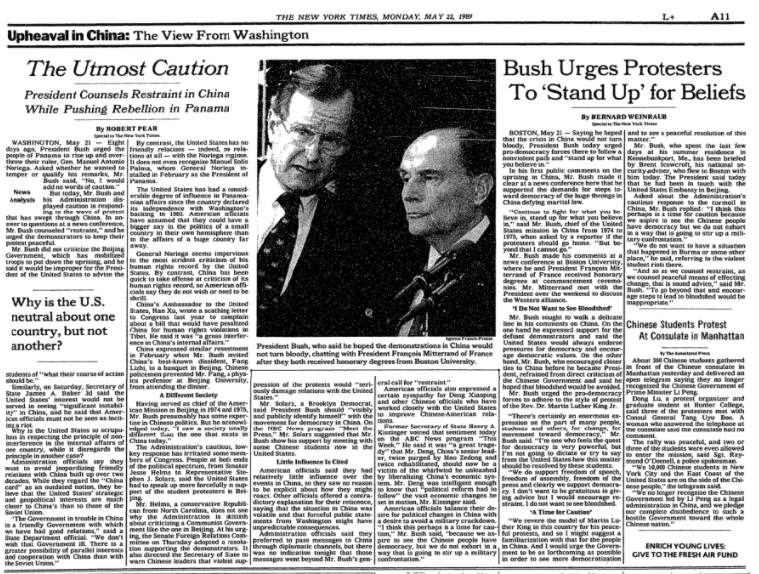
May 21, 1989 – New York Times: Eight key decision-makers. Will they be able to restore calm?
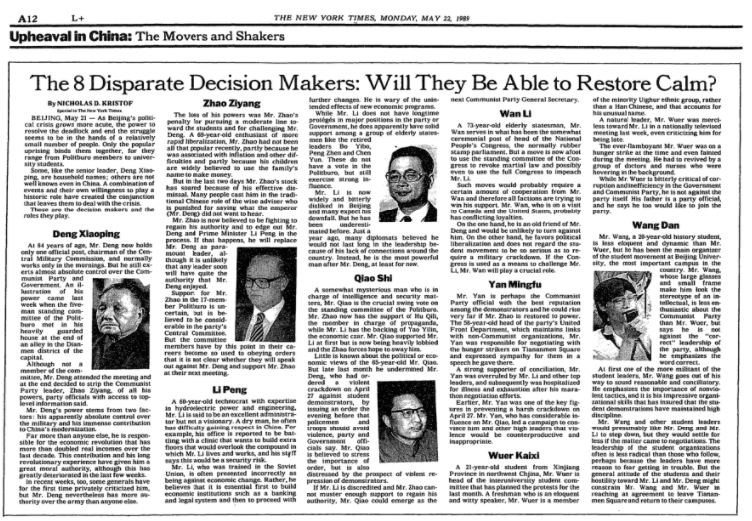
May 21-22, 1989 – More than 100,000 students, factory workers, and local residents demonstrate in front of provincial govt HQ in Guangzhou.
May 21-22, 1989 – 10,000 students and journalists demonstrate in Nanjing, workers from Nanjing Rubber Plant go on strike.
May 22, 1989 – After rumored dawn army assault does not materialize, student leaders announce preparations to withdraw from Tiananmen Square.
May 22, 1989 – New York Times: “Beijing throngs again thwart advances by troops amid sigs military balks at crackdown”.
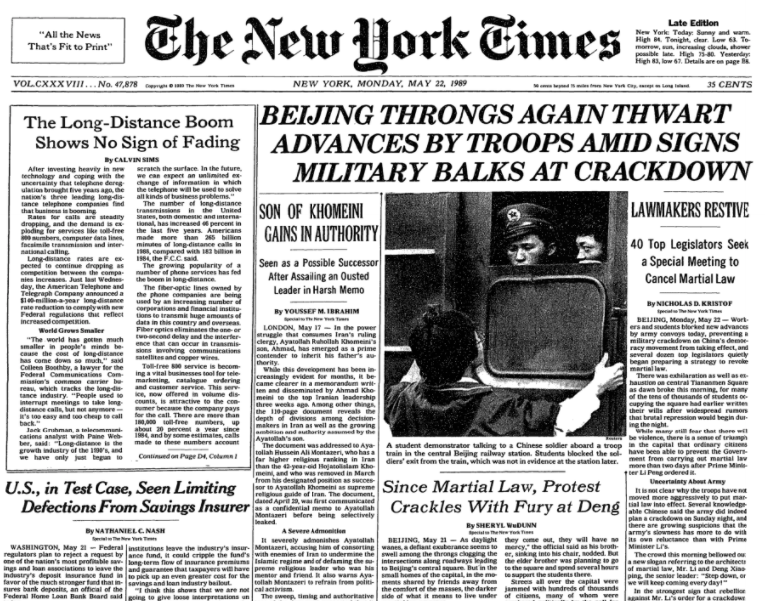
May 22, 1989 – Students dancing in Tiananmen Square, as they wait to see how martial law stand-off plays out.
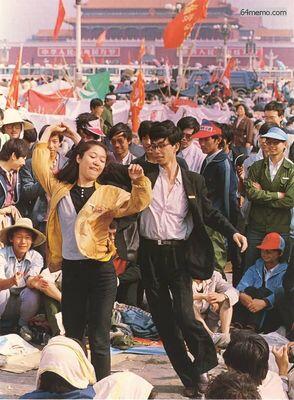
May 22, 1989 – Amid disagreement among student leaders, plans to withdraw from Tiananmen Sq are countermanded. Conflicting orders circulate.
May 22, 1989 – 3:00pm: military helicopter drops flyers on Tiananmen Square
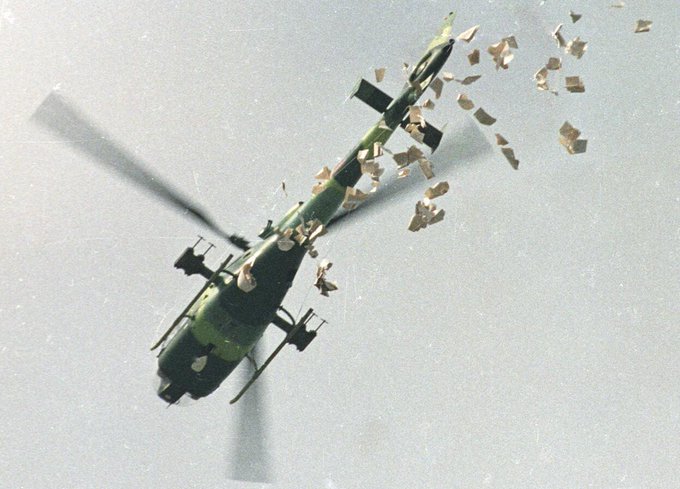
May 22, 1989 – Flyers dropped from military helicopter flutter down on students in front of Great Hall of the People.
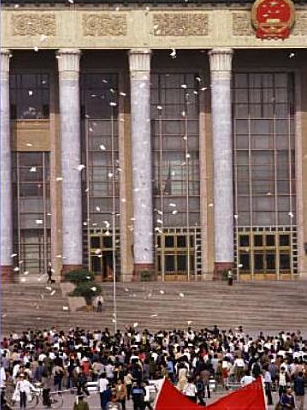
Read CIA intelligence assessment of growing unrest in China, dated May 22, 1989: http://www2.gwu.edu/~nsarchiv/NSAEBB/NSAEBB47/doc9.pdf
May 22, 1989 – Hong Kong stock market plunges 11% in panic over Tiananmen Square unrest, martial law.
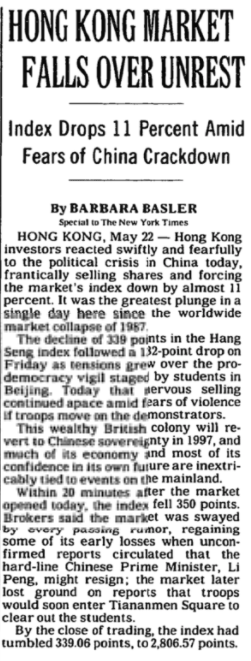
May 22, 1989 – Students in Taiyuan visit factories and army barracks to gather support, 10,000 demonstrate in city’s main square.
May 22, 1989 – 20,000 students and workers demonstrate in Xi’an, blocking traffic in downtown area.
May 23, 1989 – New York Times: Radio broadcasts report pro-student demonstrations breaking out all over China.
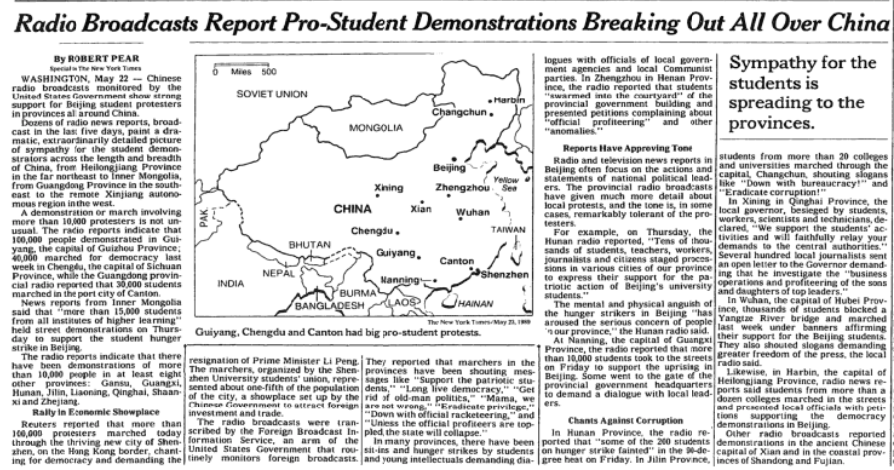
May 23, 1989 – New York Times: Standoff persists in Beijing, top generals warn army “must not enter city”, rumors of Deng Xiaoping stepping down.
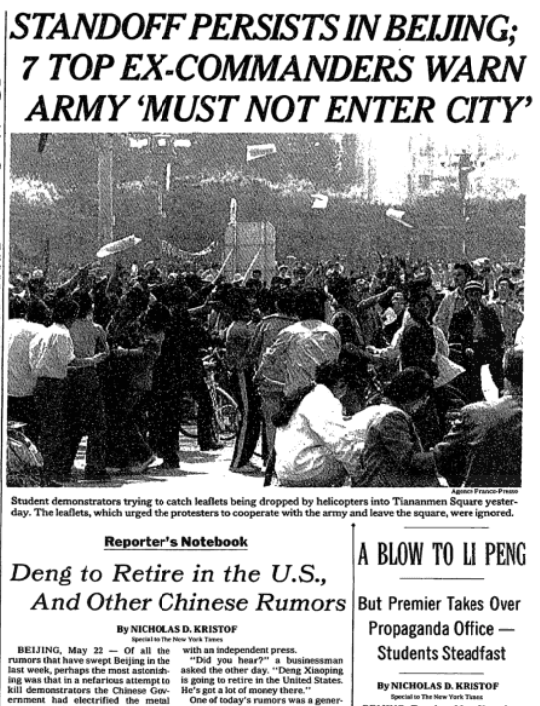
May 23, 1989 – 300,000 protesters march in streets of Beijing, largest demonstration since declaration of martial law.
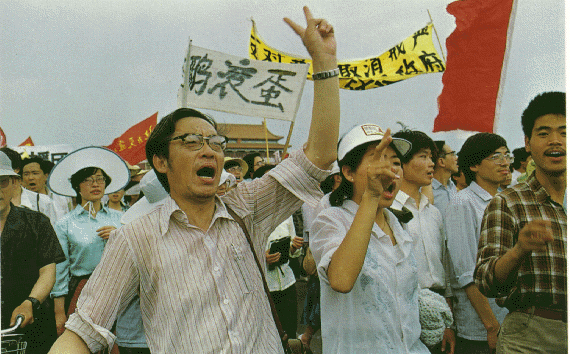
May 23, 1989 – 2:00pm: Four people throw ink-filled eggs at official portrait of Mao Zedong on the Gate of Heavenly Peace.
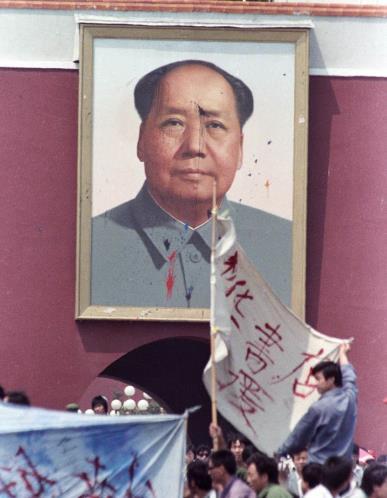
May 23, 1989 – Students seized the vandals & handed them over to police; the damaged portrait was quickly covered up.
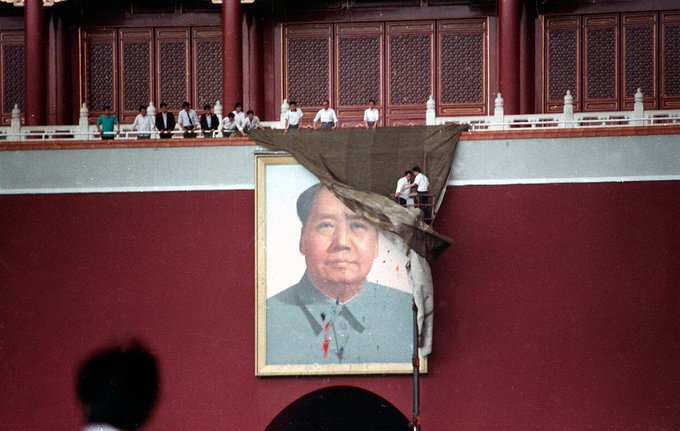
May 23, 1989 – New York Times: China’s army may be trying to avoid crisis.
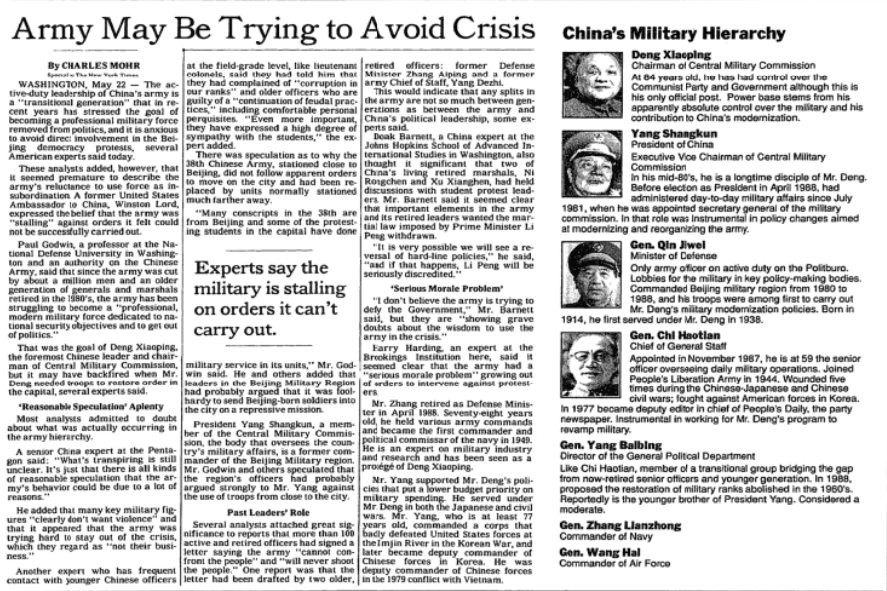
May 23, 1989 – 400,000 students march in Guangzhou, 50,000 in Shanghai; smaller demos in Harbin, Changchun, Shenyang, Jinan, Hangzhou.
May 23, 1989 – Protest march continues despite afternoon rainstorm. Note Mao’s vandalized portrait is covered up.
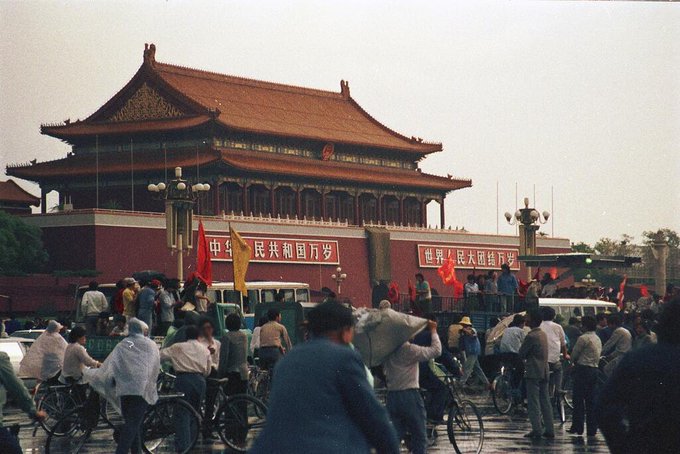
May 23, 1989 – New York Times: Silence and anxiety from China’s neighbors in Asia.
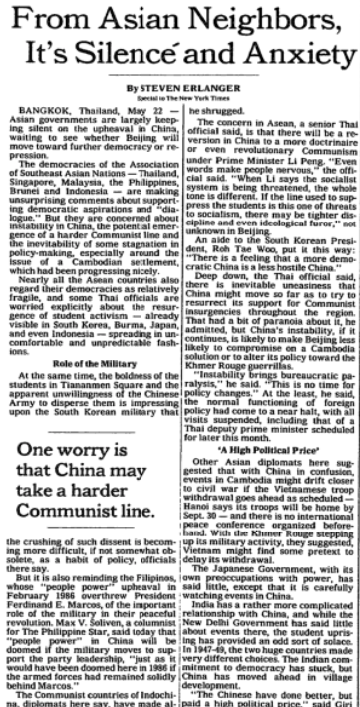
May 23, 1989 – Night at Tiananmen. By now, small military units had quietly secured key locations across Beijing.
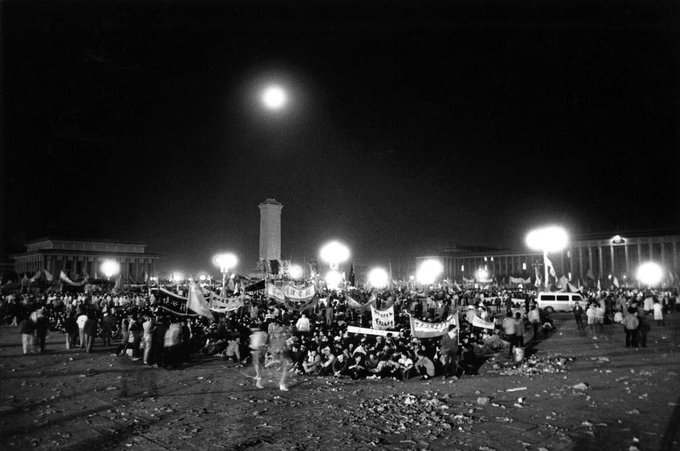
May 24, 1989 – New York Times: “Chinese take umbrage at attack on Mao portrait”
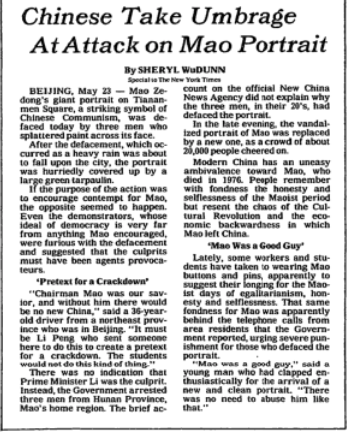
May 24, 1989 – New York Times: Travels urged to delay trips to China.
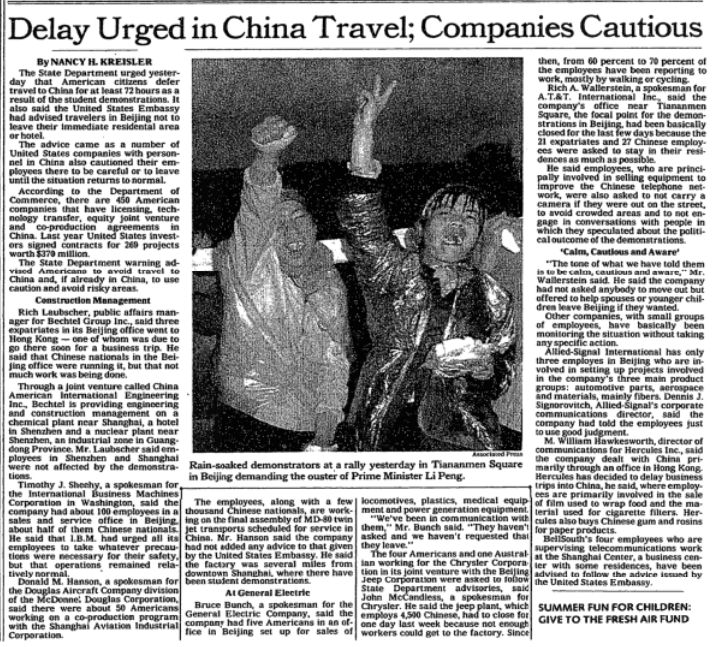
May 24, 1989 – Student-occupied Tiananmen Square, after heavy rains the night before
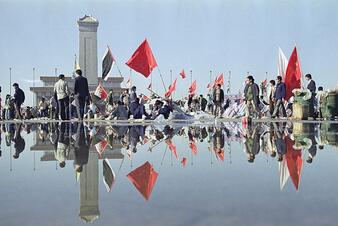
May 24, 1989 – New York Times: “Changes at top are hinted as leaders meet in Beijing; some troops begin to leave”.
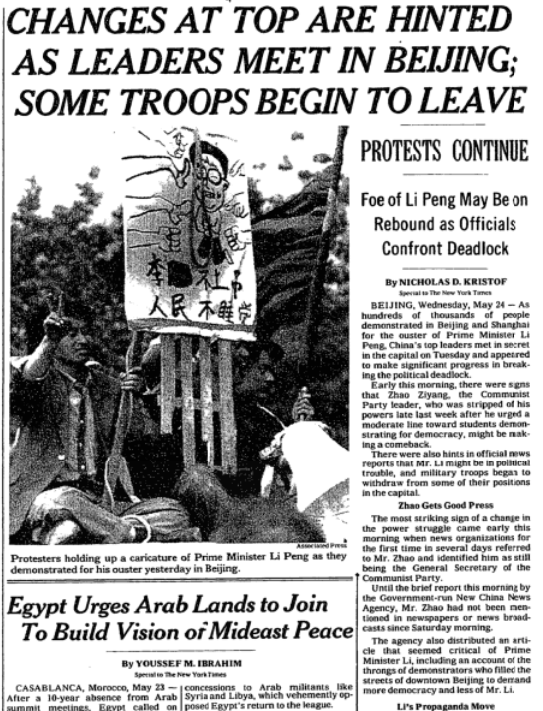
May 24, 1989 – New York Times: China’s own press boldly and subtly tests the limits of censorship.
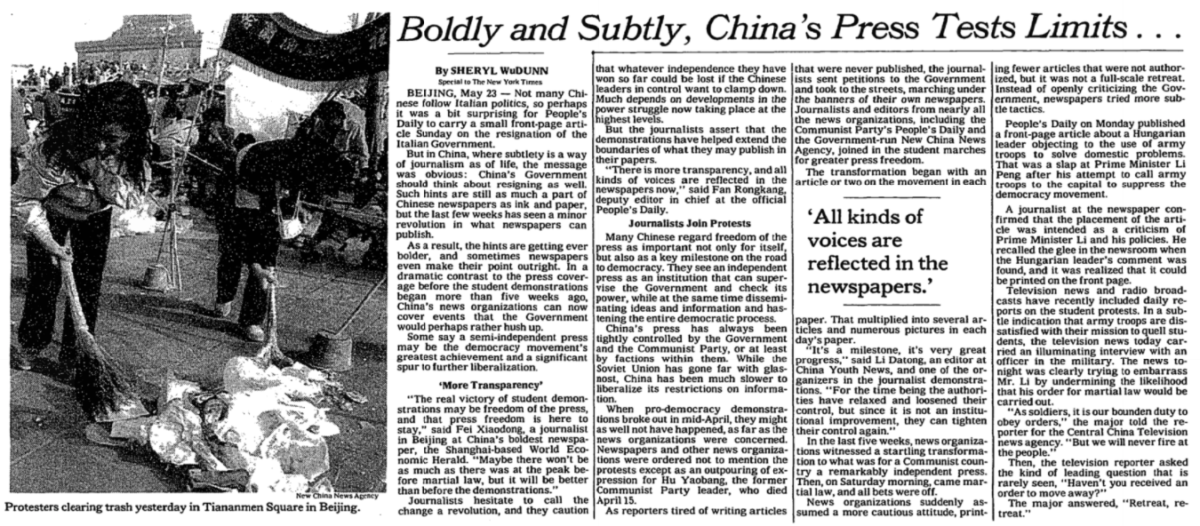
May 24, 1989 – 100,000 students in Tiananmen take oath to defend the square and “struggle to the end”.
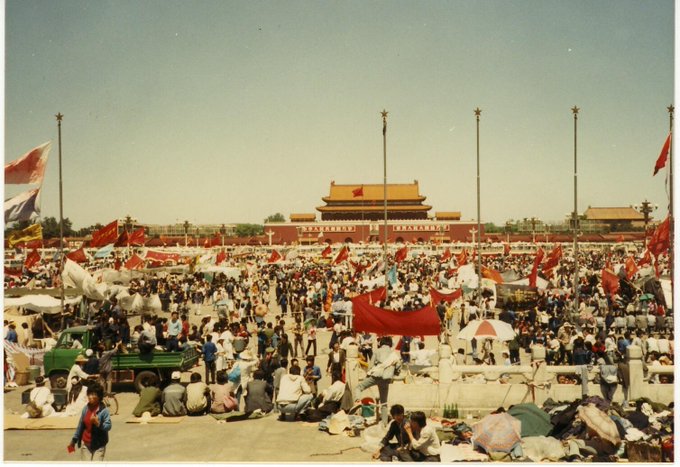
May 24, 1989 – Student protests reported in Chongqing, Shijiazhuang, Changsha, Xi’an, and Guiyang, nationwide rail traffic interrupted.
May 24, 1989 – New York Times: China allows foreign media to resume broadcasts.
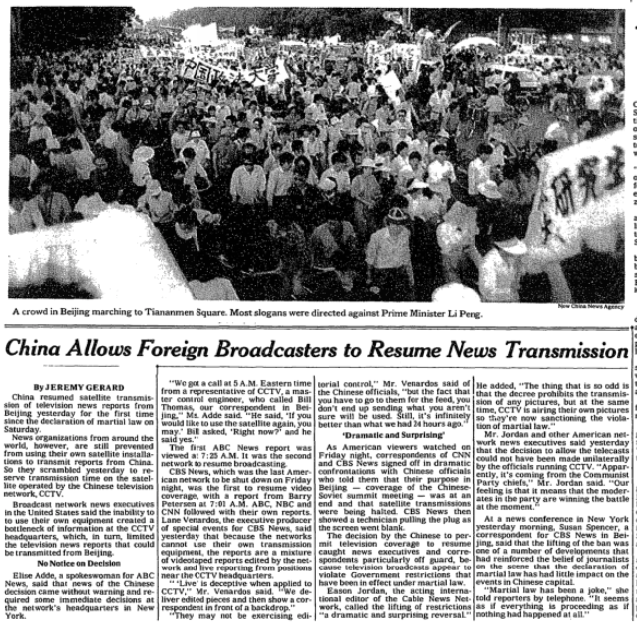
May 24, 1989 – New York Times: President Bush calls for non-violence and restraint.
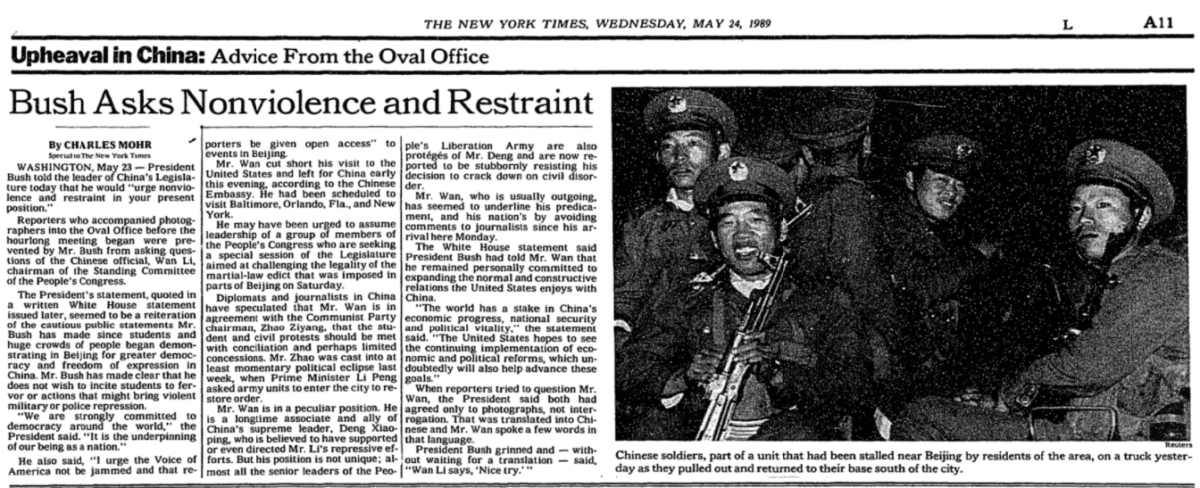
May 25, 1989 – 100,000 demonstrators in Beijing call for emergency NPC meeting, Li Peng’s removal, and Wan Li’s return.
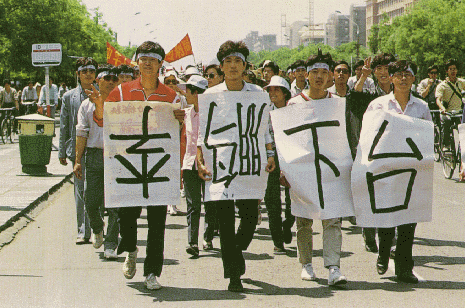
May 25, 1989 – New York Times: As standoff continues, China’s student protesters face the prospect of taking their exams.
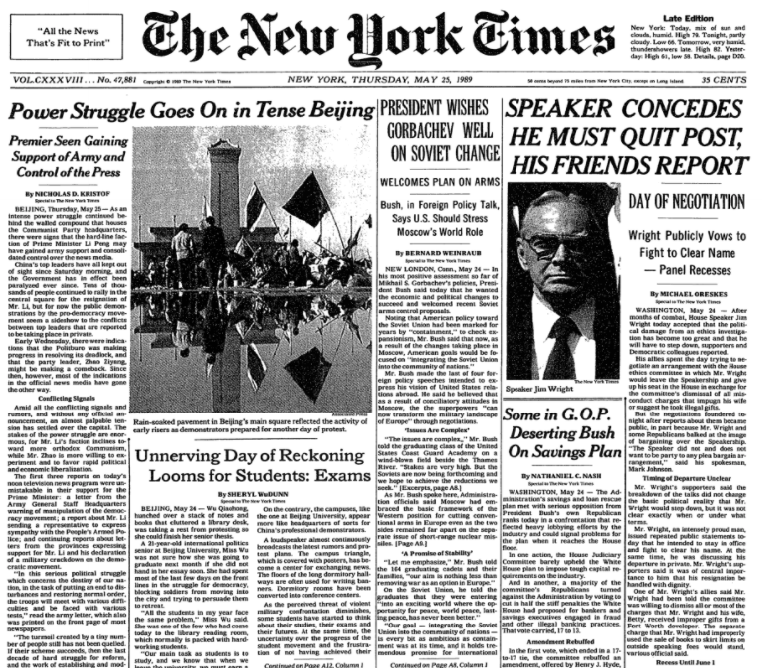
May 25, 1989 – New York Times: Many student protest leaders are children on top bureaucrats.
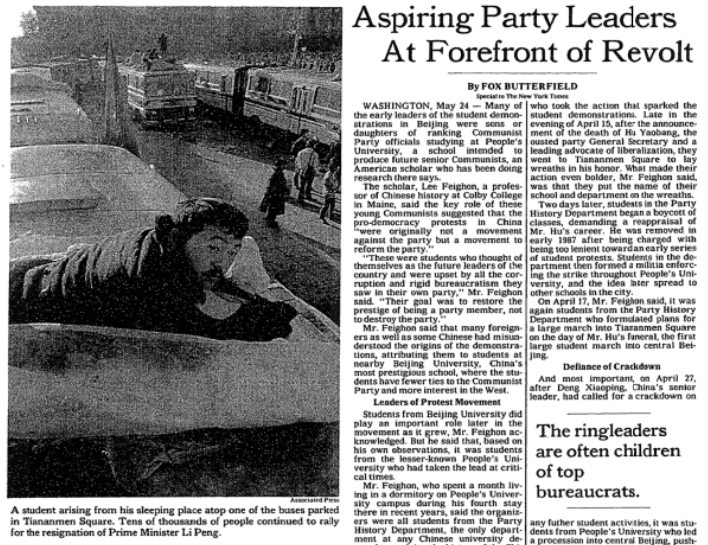
May 25, 1989 – Protesters in Tiananmen hold up banner demanding “No U-Turn”.
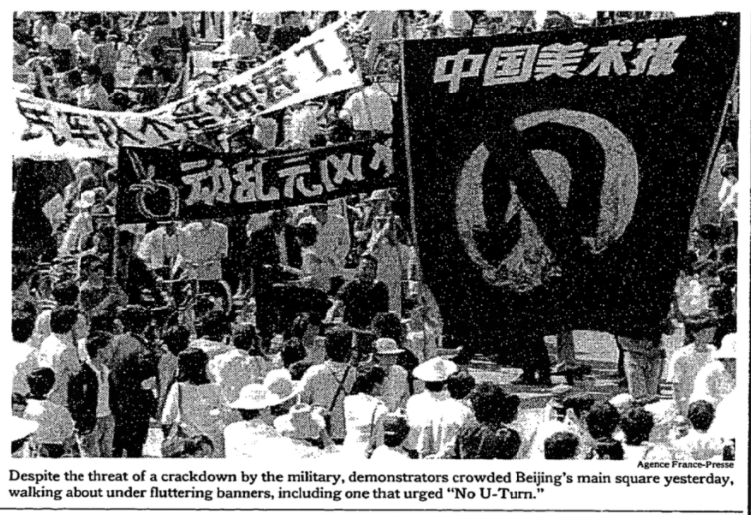
May 25, 1989 – Large marches take place in Shanghai, Tianjin, Chengdu, & Guiyang, calling on NPC to remove Li Peng. Rail service disrupted.
May 25, 1989 – New York Times: Students protest in Guangdong, in southern China. “An area usually intent on business decides to get involved.”
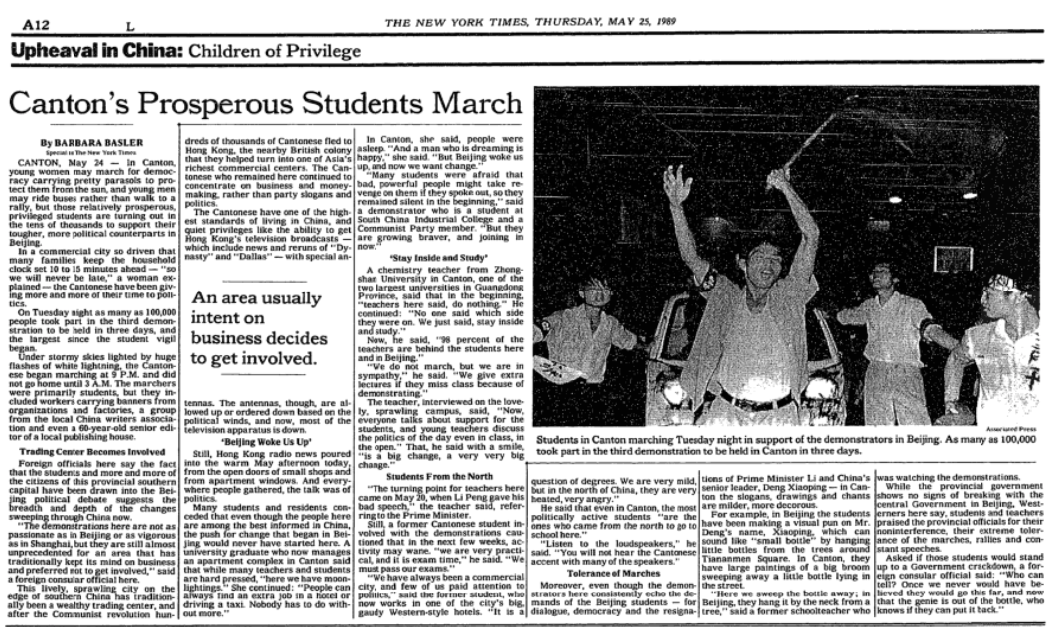
May 25, 1989 – Wan Li, reformist Chairman of National People’s Congress (NPC), returns from official visit to US, is detained in Shanghai.
May 25, 1989 – Petition circulates among NPC Standing Committee calling for emergency meeting and ouster of hardline Premier Li Peng.
May 25, 1989 – New York Times: China’s top leaders are reportedly in chaos: “the whole leadership has come unglued”.
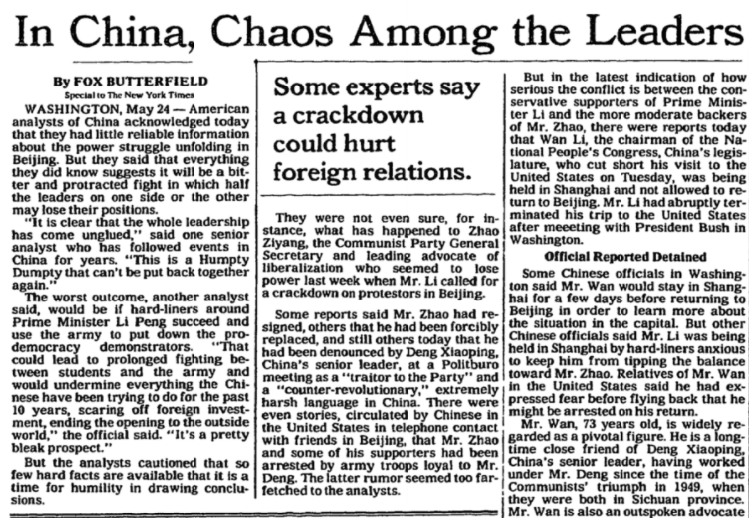
May 25, 1989 – New York Times: Power struggle goes on in tense Beijing; China again cuts off TV news transmissions.
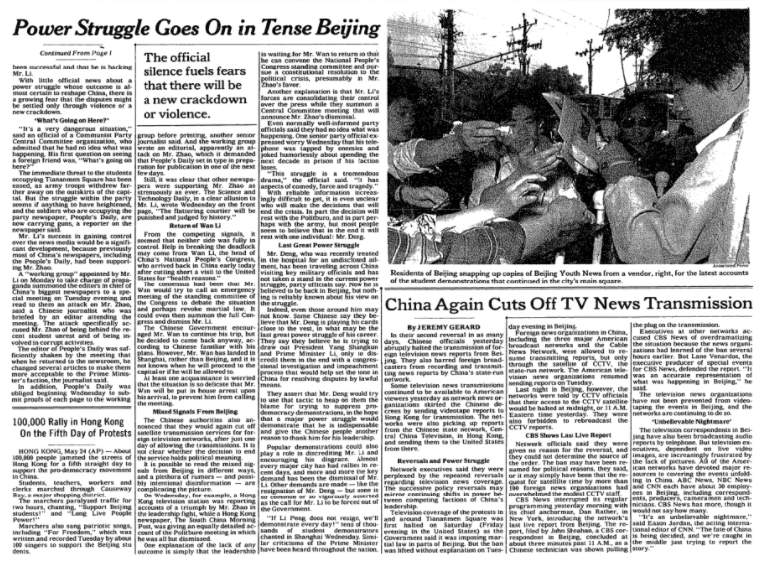
May 26, 1989 – BBC translator Philip Cunningham and “commander-in-chief” Chai Ling in front of student command center in Tiananmen Square.
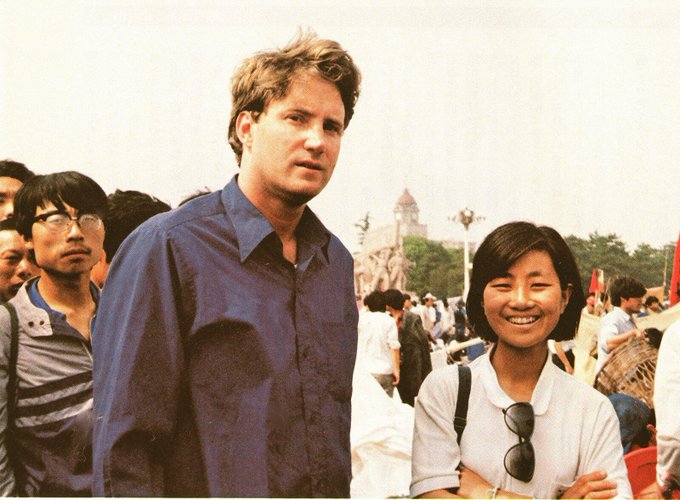
May 26, 1989 – New York Times: Protesters discuss what to do if Zhao Ziyang is removed from power; 26-year-old Beijing teacher: “If the government is incapable of solving the problem, it should be dissolved”.
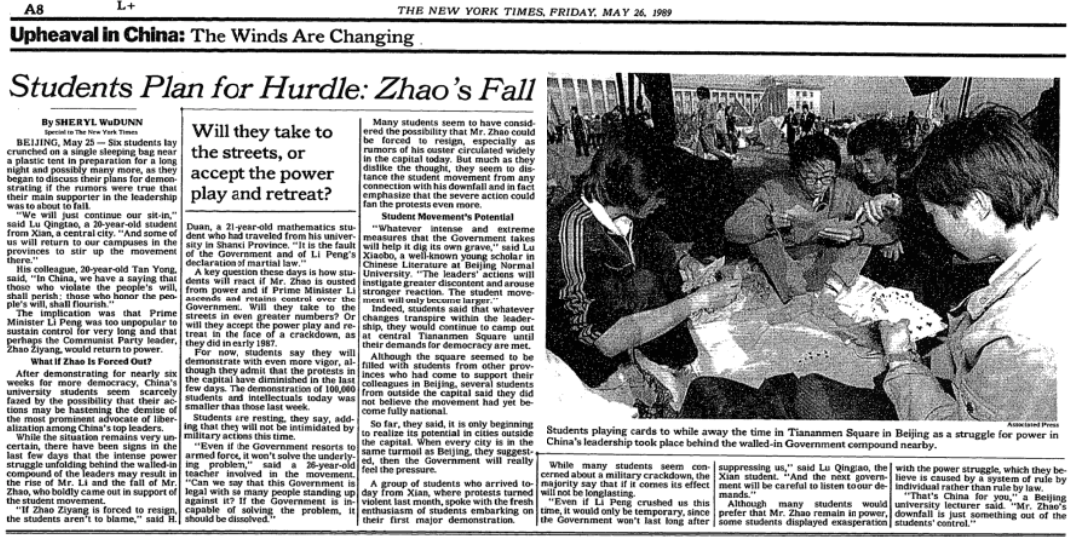
May 25, 1989 – Liu Xiaobo tells New York Times: “Whatever extreme measures that the government takes will help it dig its own grave.”
May 26, 1989 – New York Times: Military movements in Beijing suggests signs of a coming crackdown.
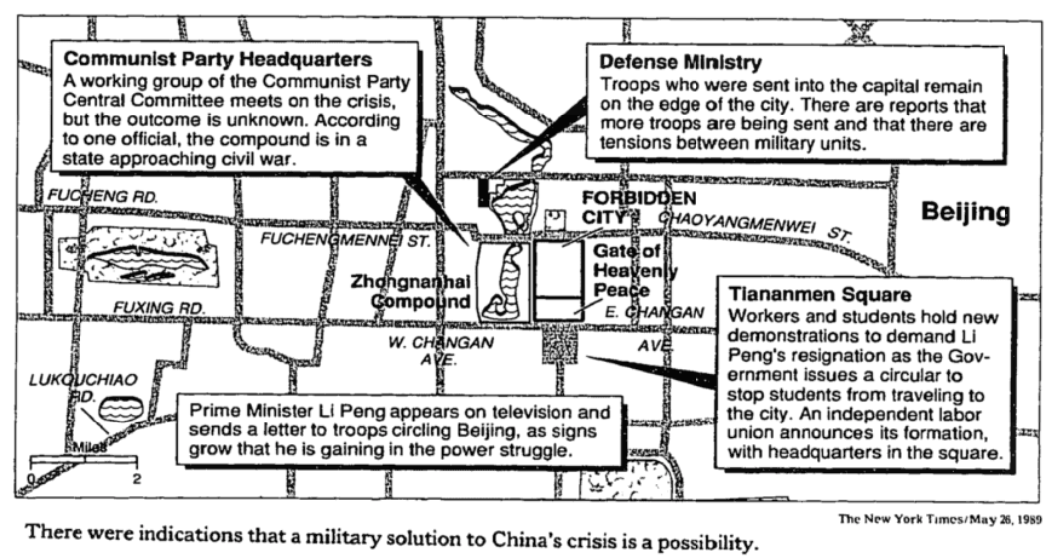
May 26, 1989 – New York Times: The political winds are favoring hard-liner Li Peng.
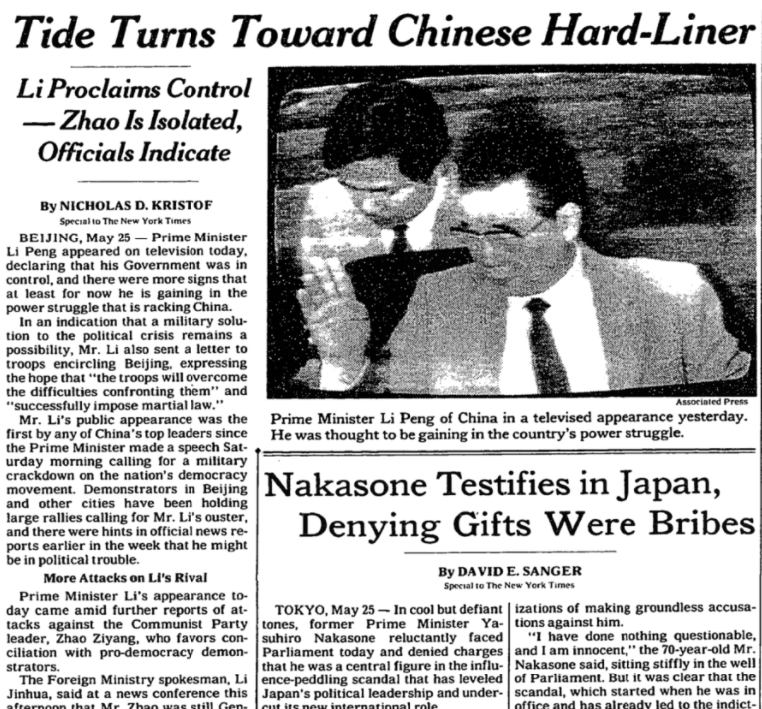
May 26, 1989 – Workers spray disinfectant in Tiananmen Square to protect protesters camped there.
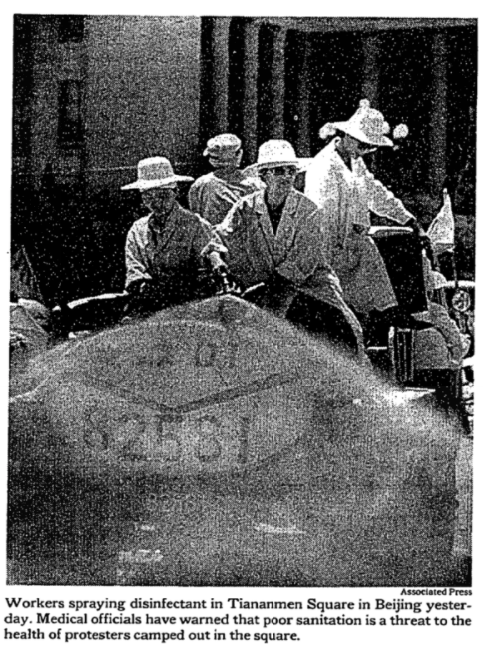
May 26, 1989 – Student leaders are discussing one last big demonstration before withdrawing from Tiananmen Square.
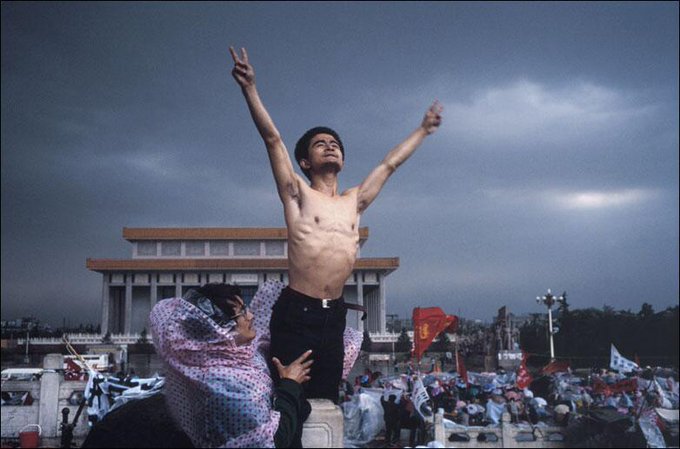
May 26, 1989 – U.S. State Department warns Americans not to travel to China “until further notice”.
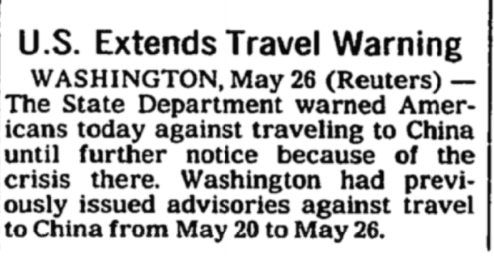
May 27, 1989 – Students at Beijing’s Central Academy of Fine Arts constructing the “Goddess of Democracy”.
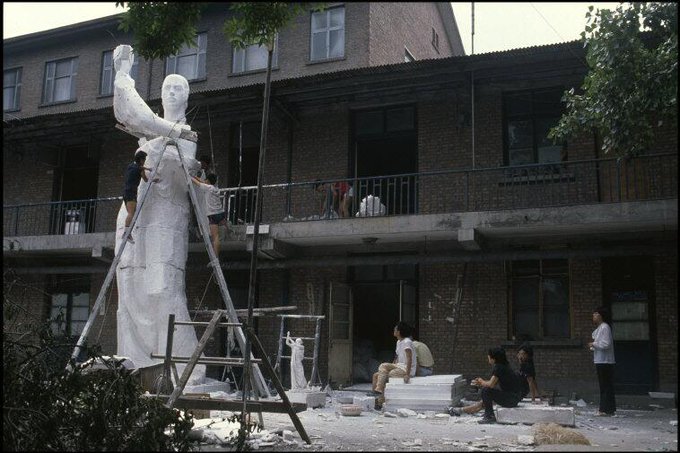
May 27, 1989 – Textile worker: “If blood is spilled in Beijing, the workers in Shanghai would mount a general strike”.
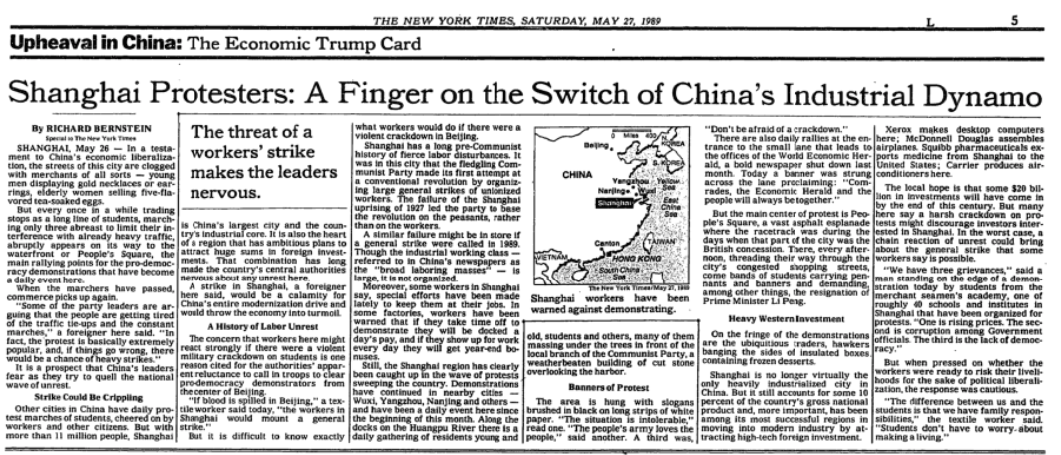
May 27, 1989 – Protest banners in Shanghai: “The situation is intolerable” “Don’t be afraid of a crackdown”.
May 27, 1989 – Student demonstrators protest at main gate to Beijing’s Zhongnanhai leadership compound.
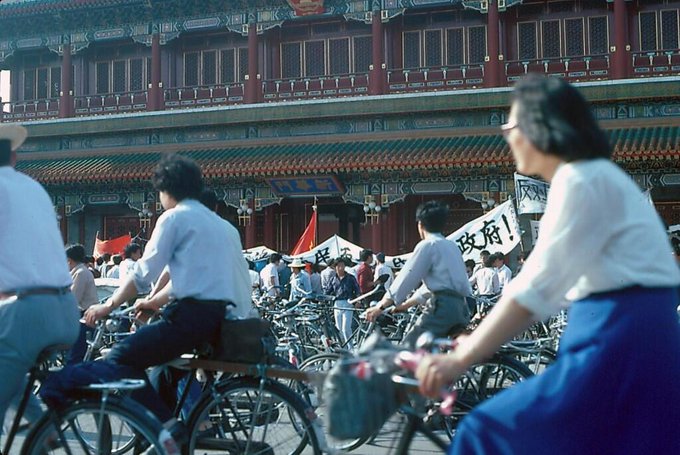
May 27, 1989 – Medical aid station in student-occupied Tiananmen Square.
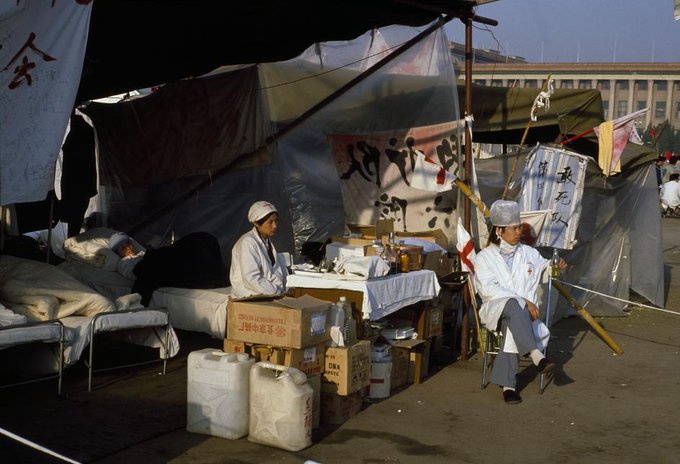
May 27, 1989 – Student leaders issue conflicting message about whether they plan to withdraw from Tiananmen Square.
May 27, 1989 – Wang Dan: “It has been proposed to the Capital Joint Liaison Group that the students evacuate Tiananmen Square on May 30.”
May 27, 1989 – Li Lu: “They’ll throw us in jail. You’re talking defeat. They’ve given us nothing we asked for. All our hopes will be gone!”
May 27, 1989 – “Unless a special meeting of the NPC is convened in the next few days, occupation of the square will continue until June 20.”
May 27, 1989 – New York Times: Thousands of students are leaving Beijing to return home to the provinces.
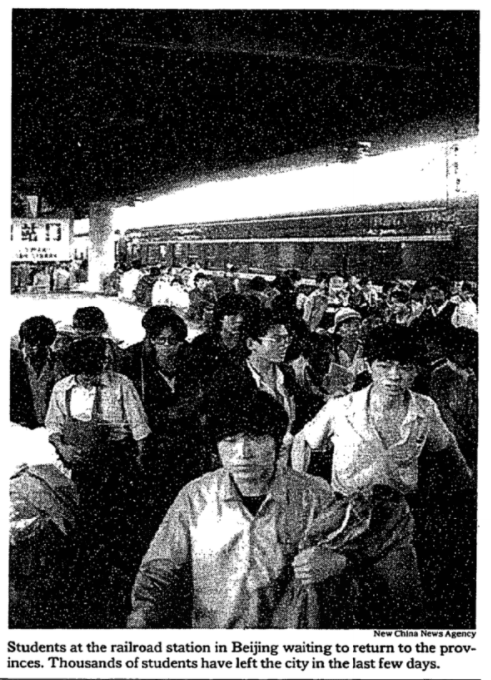
May 27, 1989 – New York Times: Will student protesters turn into radical Red Guards?
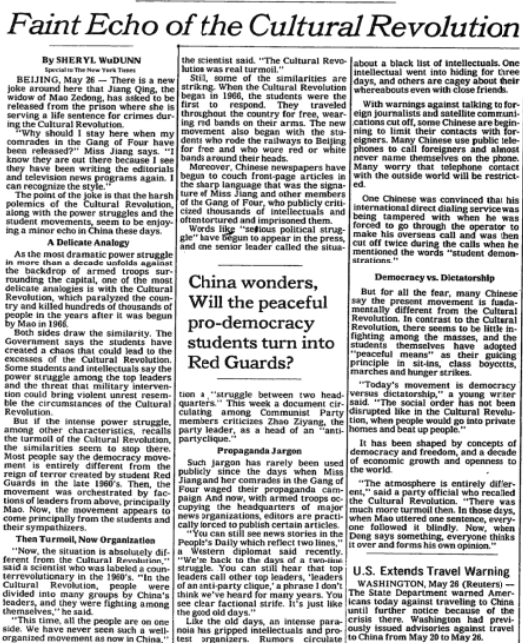
May 27, 1989 – State Security Bureau declares that any truck driver transporting the Goddess would lose their license.
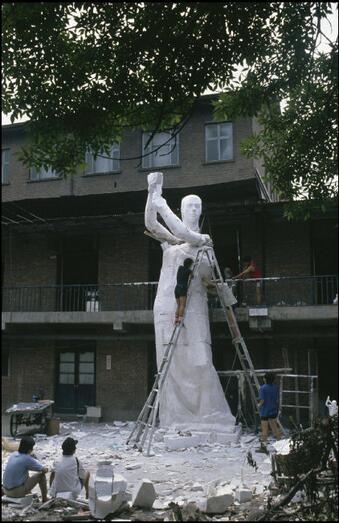
May 27, 1989 – That evening, Communist Party elders formally select Shanghai boss Jiang Zemin to replace Zhao Ziyang as general secretary.
May 27, 1989 – Li Xiannian: “[Jiang Zemin] has a political mind, is in the prime of life, and can be trusted.”
May 27, 1989 – Chen Yun: “Stability and unity of thought are the most important things.”
May 28, 1989 – A sea of demonstrators in the center of pre-handover Hong Kong show support for students in Beijing.
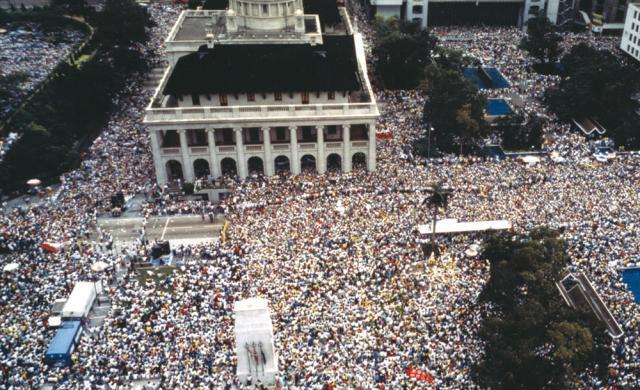
May 28, 1989 – Demonstrators in Hong Kong march in solidarity with students occupying Beijing’s Tiananmen Square
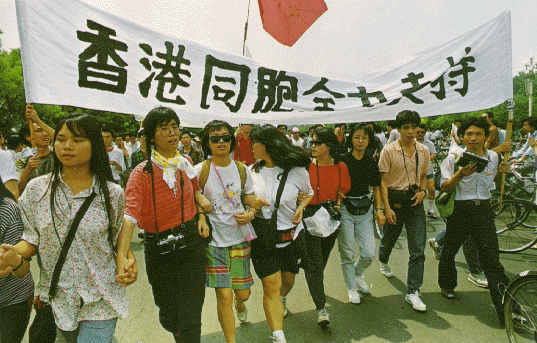
May 28, 1989 – Protesting kids hold up posters of Sun Yat-Sen in Hong Kong.
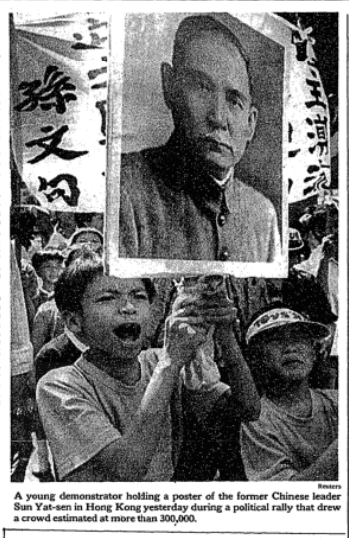
May 28, 1989 – Student spokesman details plans for big rally in Tiananmen Square over next few days.
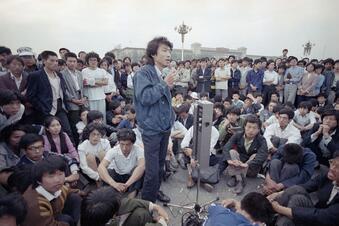
May 28, 1989 – Many students who just arrived from outside Beijing opposed plans to withdraw from Tiananmen Square.
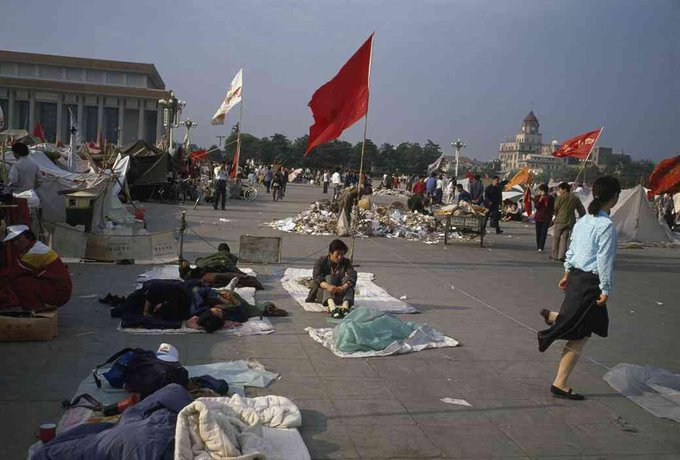
May 28, 1989 – New York Times: “The people have shown they can take things in their own hands.”
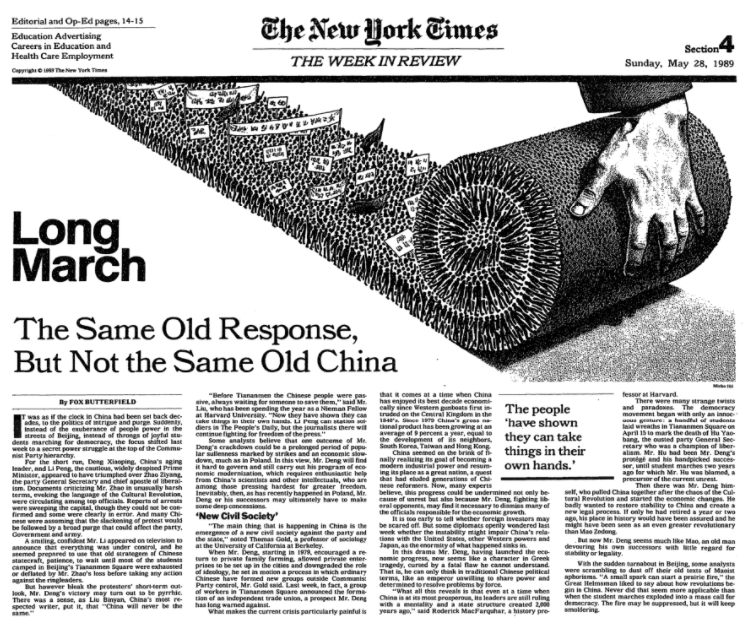
May 28, 1989 – Bao Tong (right), top aide to Zhao Ziyang, is arrested. He will spend 7 years in solitary confinement.
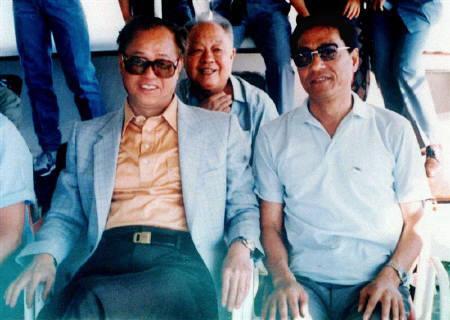
May 28, 1989 – Fearing arrest, student leader Chai Ling meets BBC reporter to record her “last will and testament”.
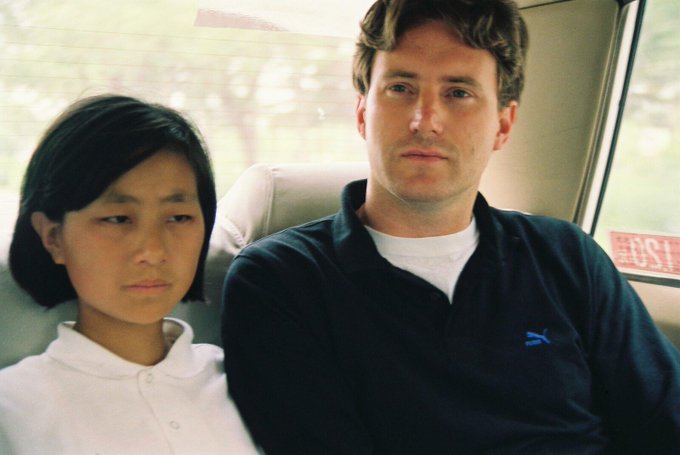
May 28, 1989 – Chai Ling: “The students always ask me. What should we do next? What could we achieve?”
May 28, 1989 – Chai Ling: “I feel deeply sad in my heart. I cannot tell them that what we are really waiting for is bloodshed.”
May 28, 1989 – Chai Ling: “only when blood is flowing like a river in Tiananmen Sq, all the people in China could then see clearly”
May 28, 1989 – Student leader Chai Ling: “I think these might be my last words, the situation is getting grim.”
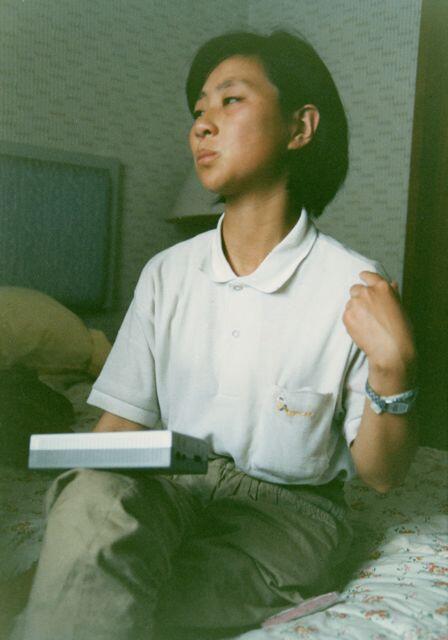
May 28, 1989 – New York Times: Tourists still visit Tiananmen Square, though climate for foreigners in Beijing grows chilly.
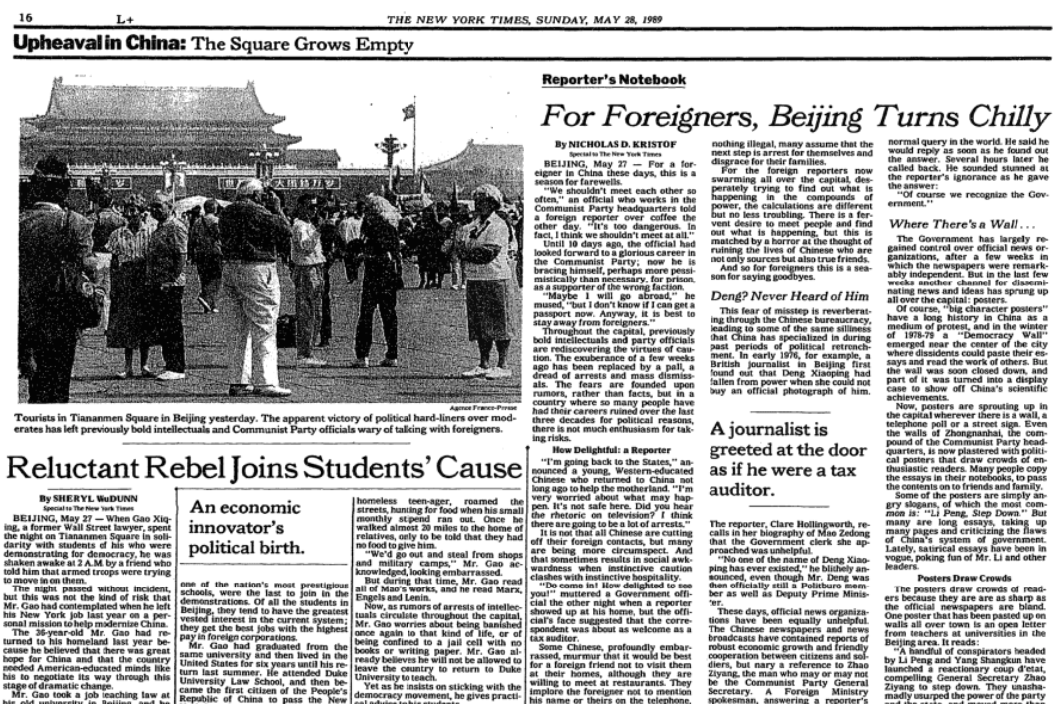
May 28, 1989 – Protesters march to Chinese consulate in Manhattan in support of students.
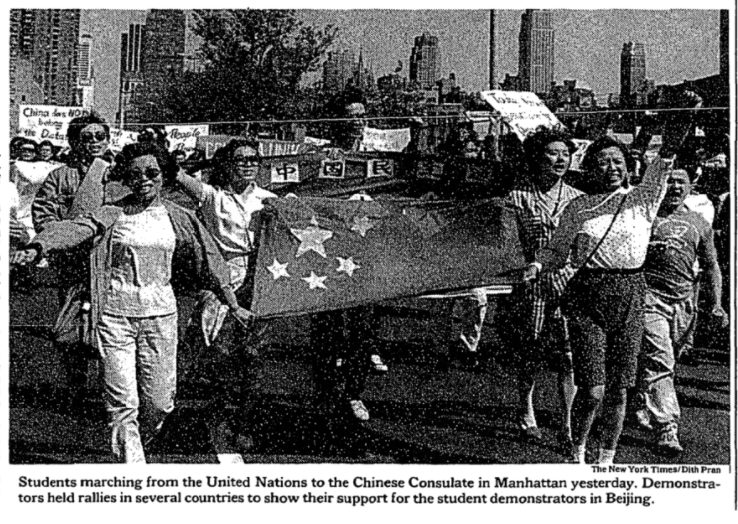
May 28, 1989 – Outside Zhongnanhai. Sign show Li Peng saying “Students, I’m coming to talk to you!” (in a tank).
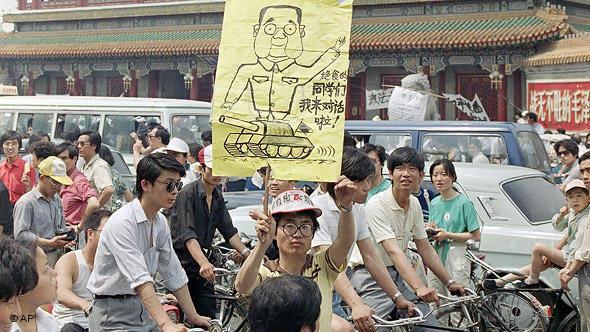
May 28, 1989 – A man who identified himself as a former political prisoner relates his experiences to striking students in Tiananmen Square.
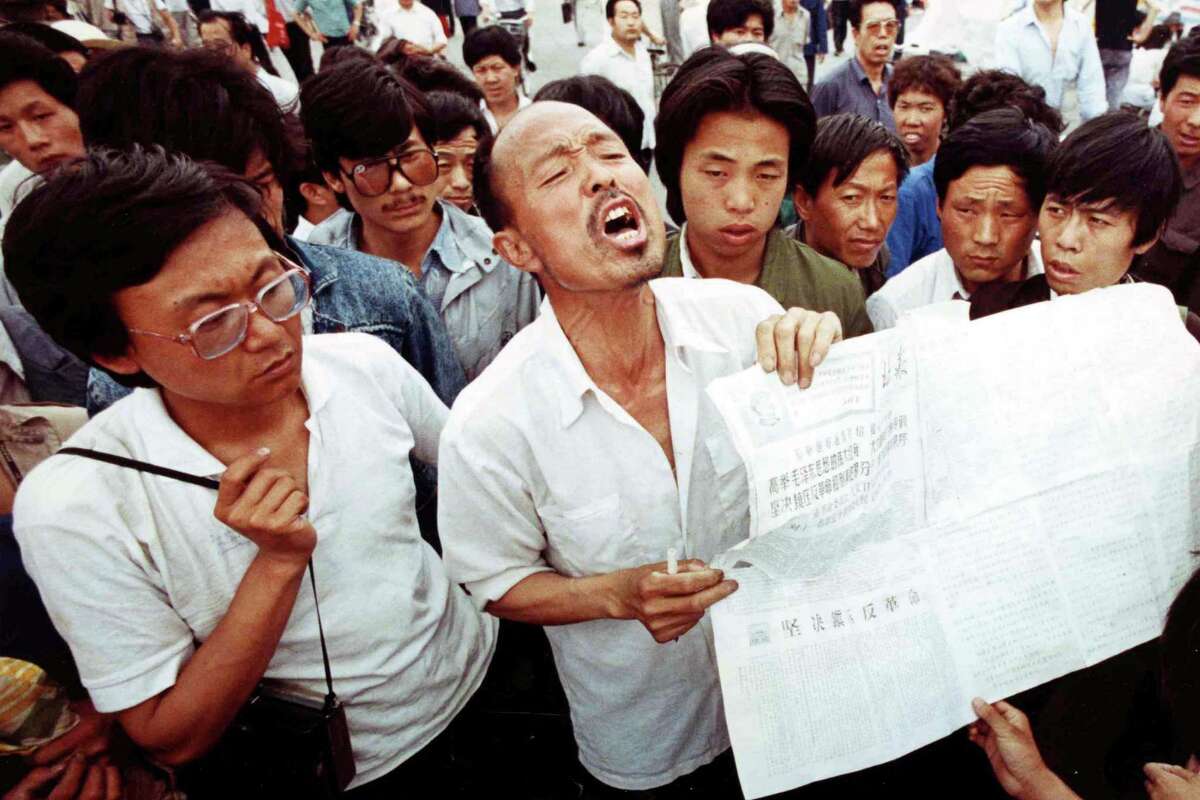
May 28, 1989 – Bicyclists in Beijing pass banners calling for Li Peng’s and Deng Xiaoping’s ouster.
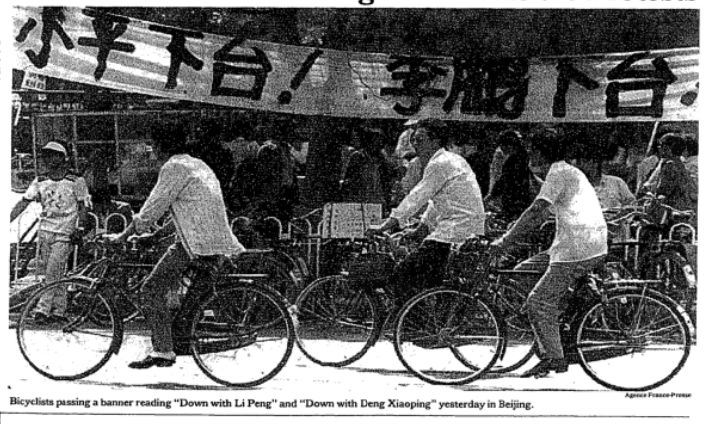
May 28, 1989 – New York Times: “Chinese students urge end to siege of Beijing square”, move to end sit-in.
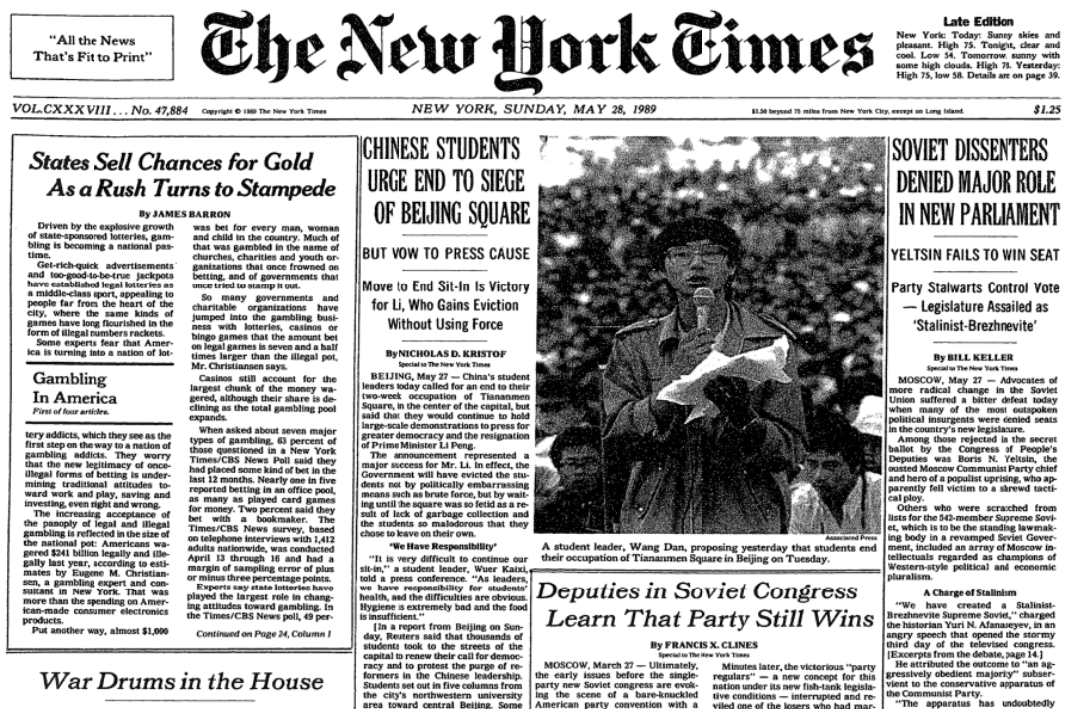
May 28, 1989 – New York Times editorial: The student protesters in China “appear to have lost” but “China’s rulers can no longer plead ignorance about what their people want.”
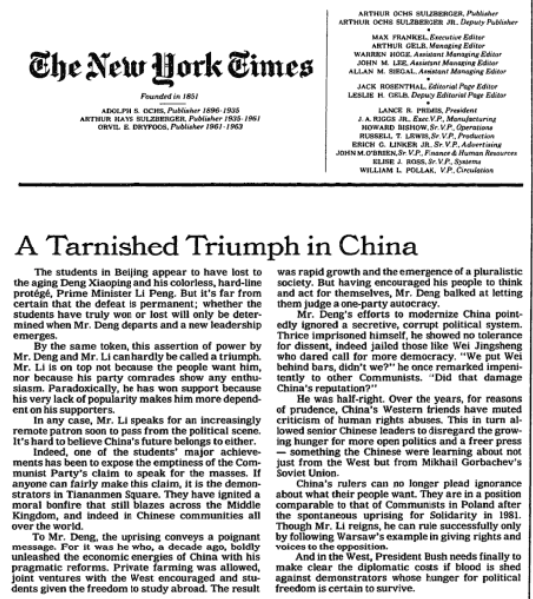
May 29, 1989 – Students begin Day 17 of their occupation of Tiananmen Square.
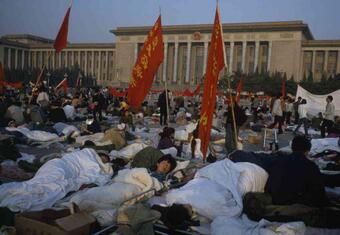
May 29, 1989 – Cover of TIME Magazine
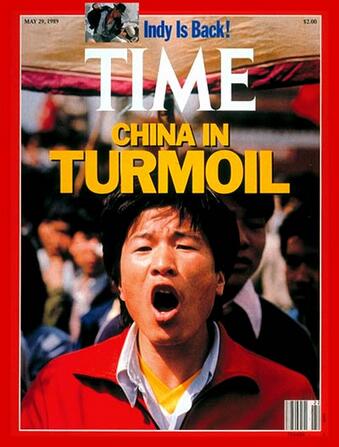
May 29, 1989 – Demonstrators march in Tiananmen Square. Banner reads “History on Trial”.
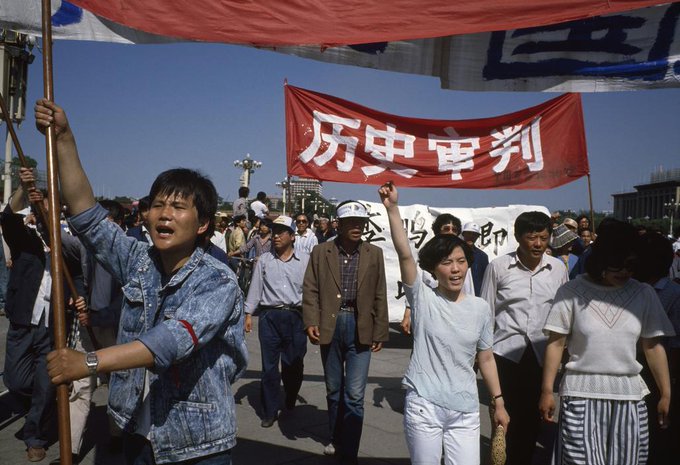
May 29, 1989 – Student protester in Tiananmen Square, six days before the crackdown.
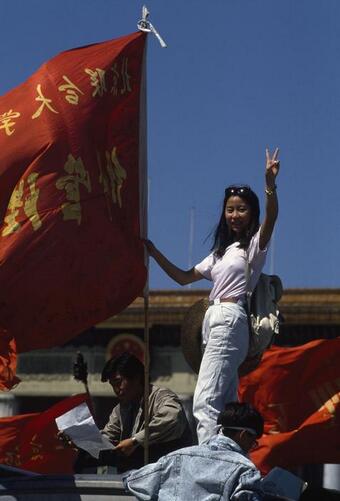
May 29, 1989 – Loudspeakers in Tiananmen Square begin blaring loud pro-government propaganda to discourage students.
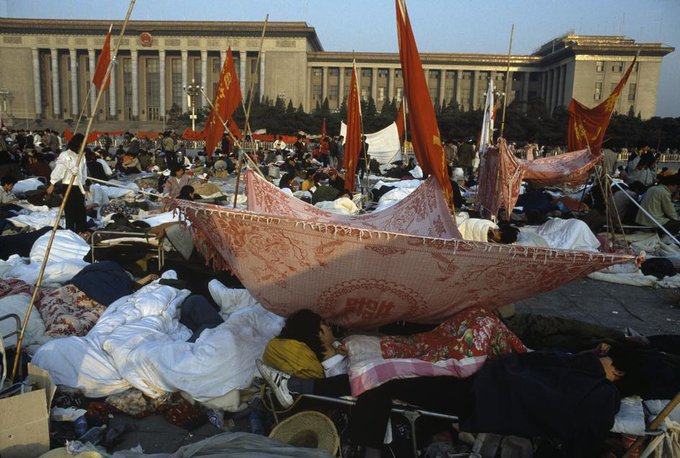
May 29, 1989 – Government loudspeaker in Tiananmen Square: “If we don’t stop the movement, we will lose the gains made during 10 years of reform.”
May 29, 1989 – Government loudspeaker: “Why did this movement begin? Because we have slackened our attention to political education.”
May 29, 1989 – Great Hall of the People looming behind these students was by now filled with unseen soldiers.
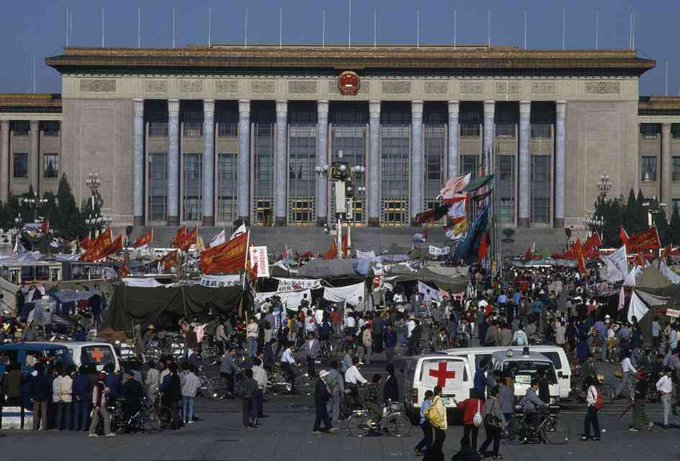
May 29, 1989 – Students occupying Tiananmen Square wave flags indicating their school and department.
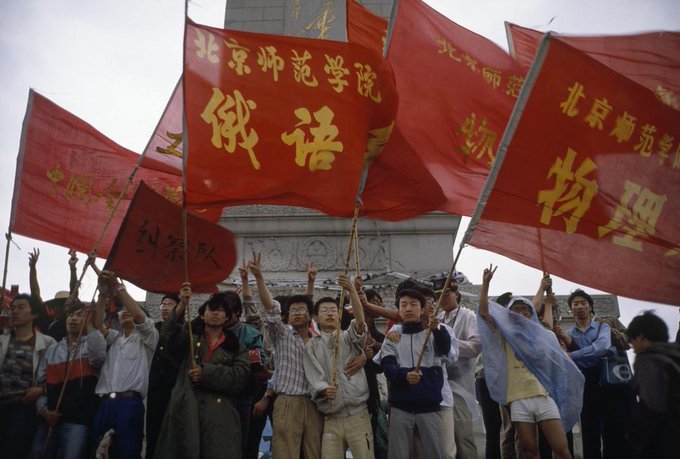
May 29, 1989 – Buddhist nun protests in Tiananmen Square under an improvised effigy of Premier Li Peng.
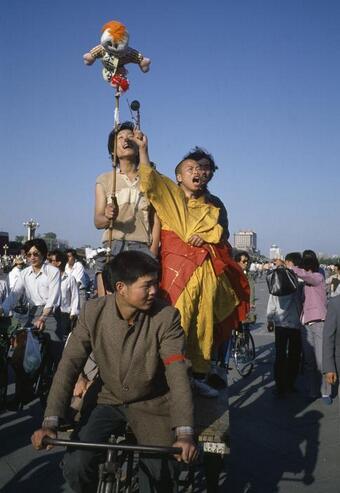
May 29, 1989 – State Security Ministry described students in Tiananmen Square this day as “lonely and listless”.
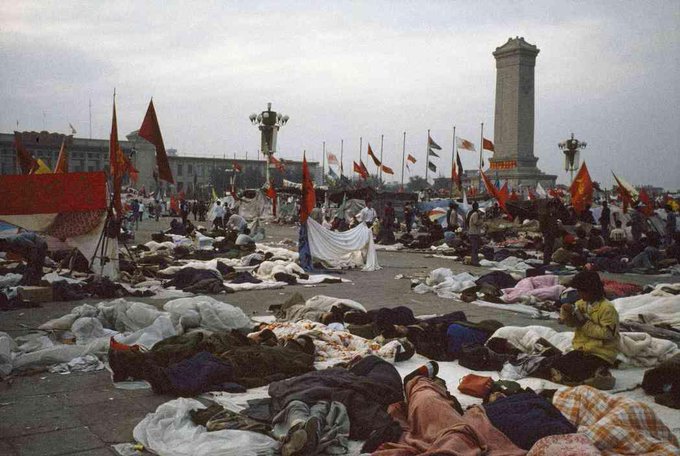
May 29, 1989 – LA Times: “Dispirited Protesters in China Vow to Carry On” http://articles.latimes.com/1989-05-29/news/mn-668_1_student-leaders-men-square-premier-li-peng… students “sullen, confused and divided”
May 29, 1989 – Municipal buses serving as both dormitories and barricades in student-occupied Tiananmen Square.
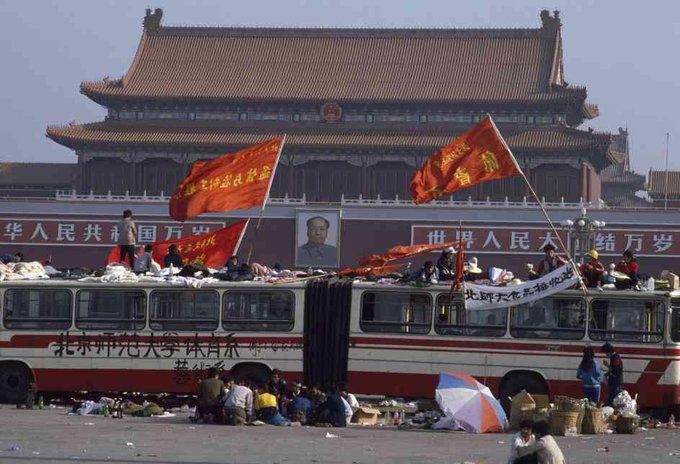
May 29, 1989 – Truck filled with medical supplies on its way down Chang’an Avenue to students in Tiananmen Square.
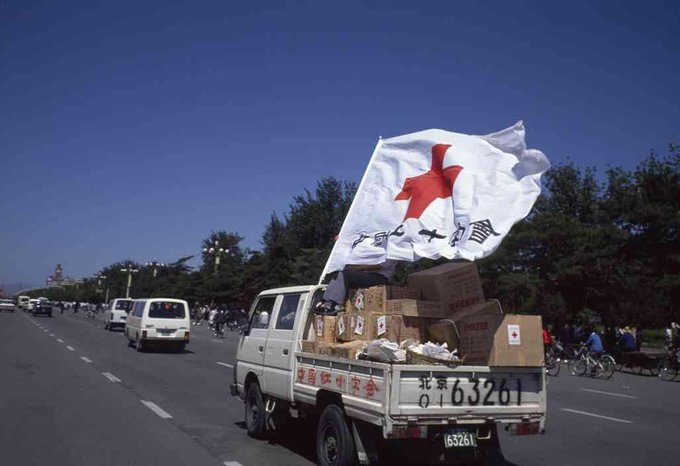
May 29, 1989 – Some smaller schools had resumed classes, but the major Beijing universities were all still on strike.
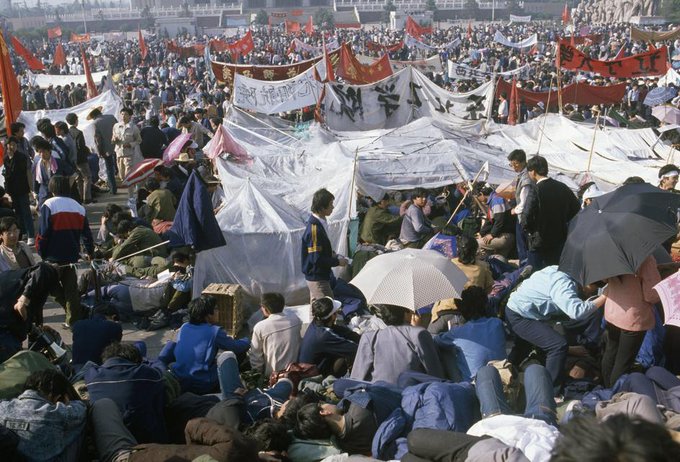
May 29, 1989 – Western diplomat tells New York Times: “The mood is that there’s trouble ahead.”
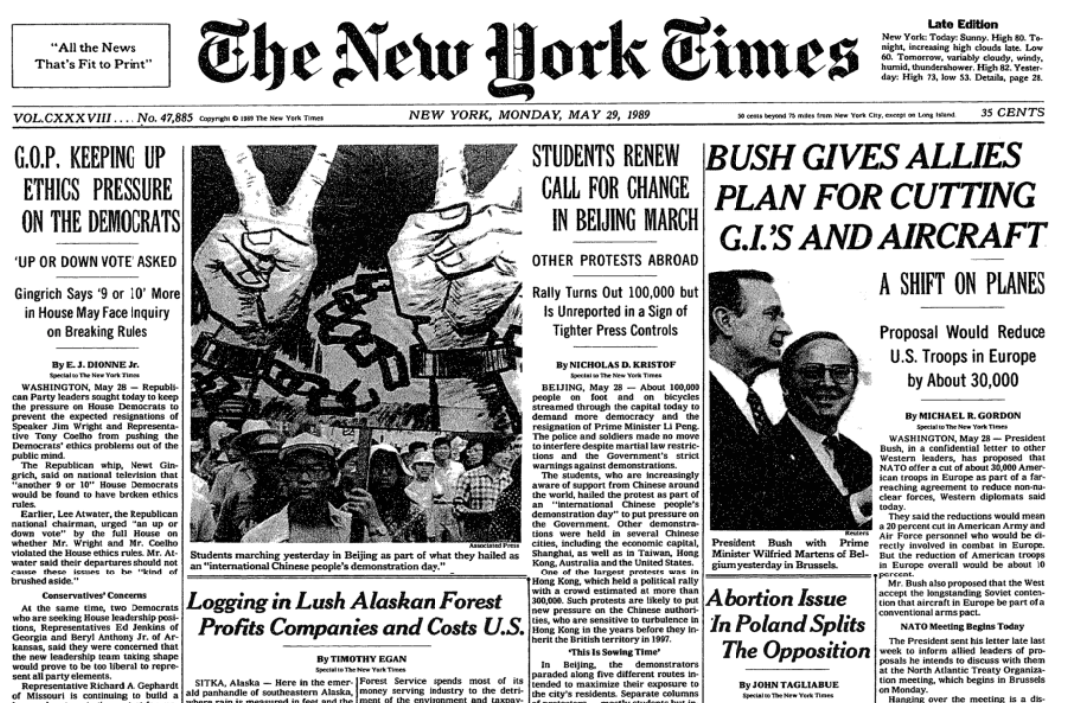
May 29, 1989 – President Yang Shangkun quoted in New York Times: “There’s no way for us to retreat. To retreat means our downfall.”
May 29, 1989 – Students camping out in Tiananmen Square.
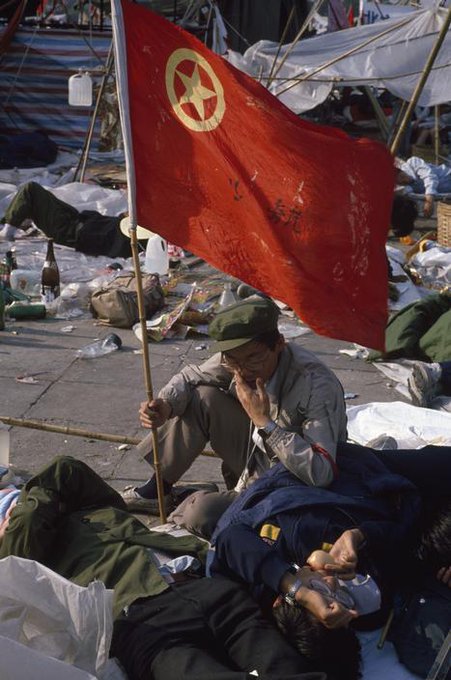
May 29, 1989 – Farmer folk singer Yang Lianzhi advertises concert in Tiananmen Square. He later was sentenced to 15 years in prison.
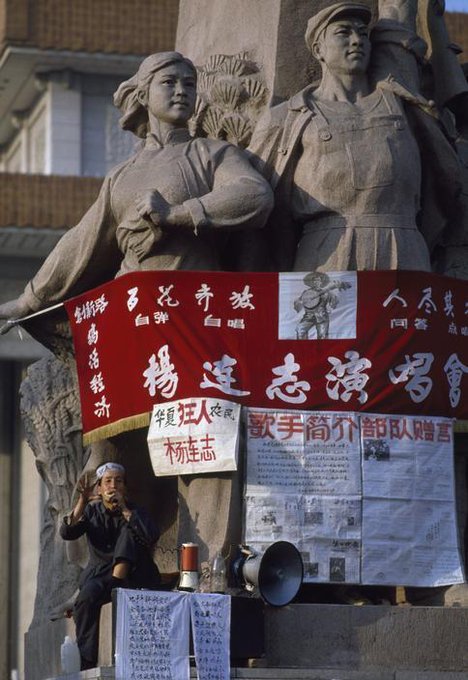
May 29, 1989 – 10:00pm: People link arms to protect Goddess of Democracy from police as it is moved to Tiananmen Square.
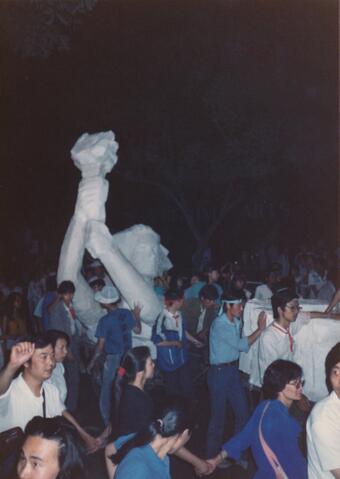
May 30, 1989 – As dawn breaks, art students construct the “Goddess of Democracy” in Tiananmen Square.
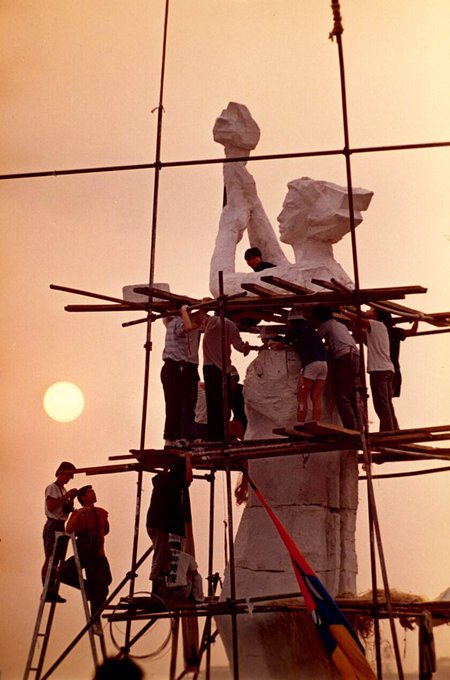
May 30, 1989 – “At this grim moment, what we need most is to remain calm and united in a single purpose.”
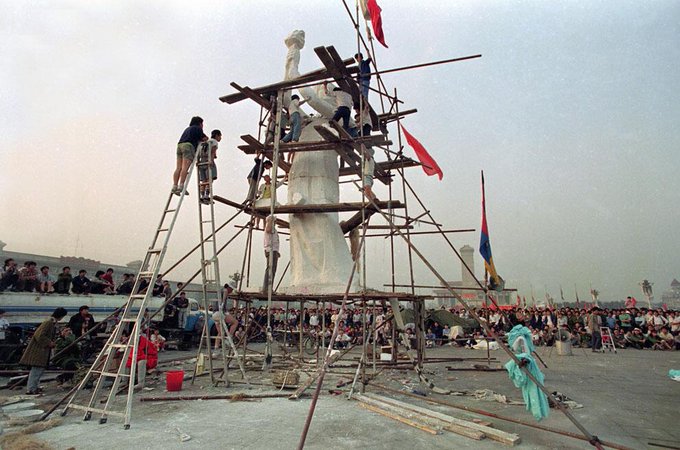
May 30, 1989 – “You are the symbol of every student in the Square, of the hearts of millions of people.”
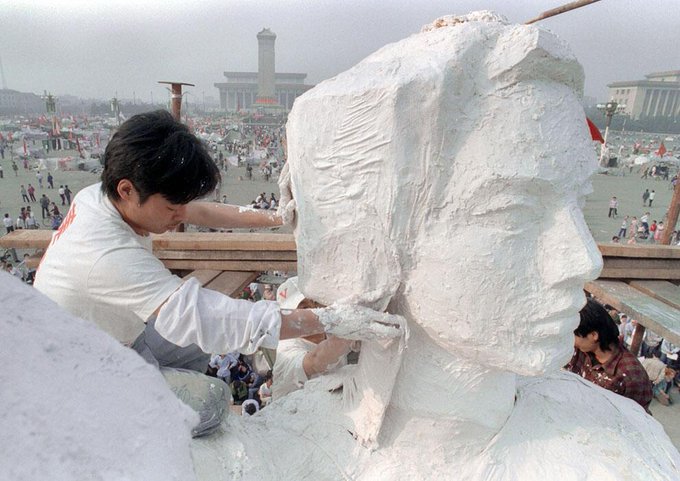
May 30, 1989 – “Today, here in the People’s Square, the people’s Goddess stands tall & announces to the whole world:”
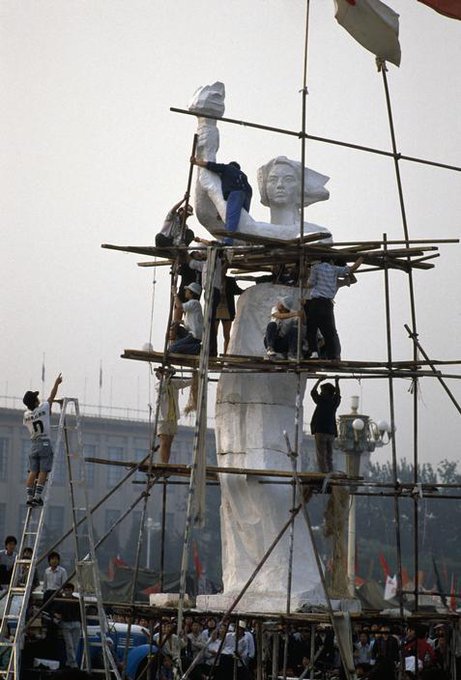
May 30, 1989 – “A consciousness of democracy has awakened among the Chinese people! The new era has begun!”
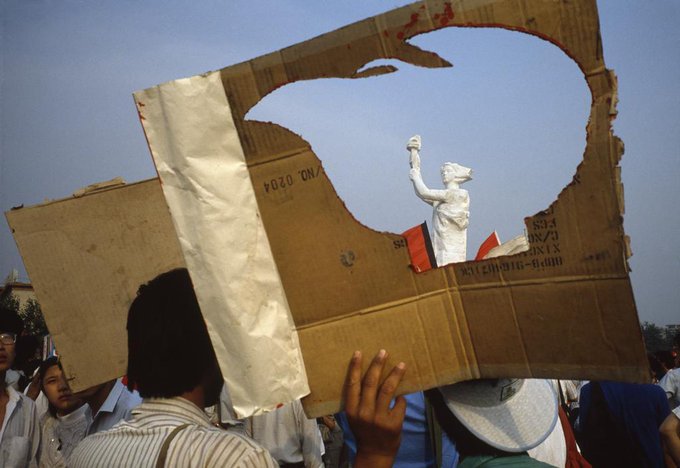
May 30, 1989 – “The statue of the Goddess of Democracy is made of plaster, and of course cannot stand here forever.”
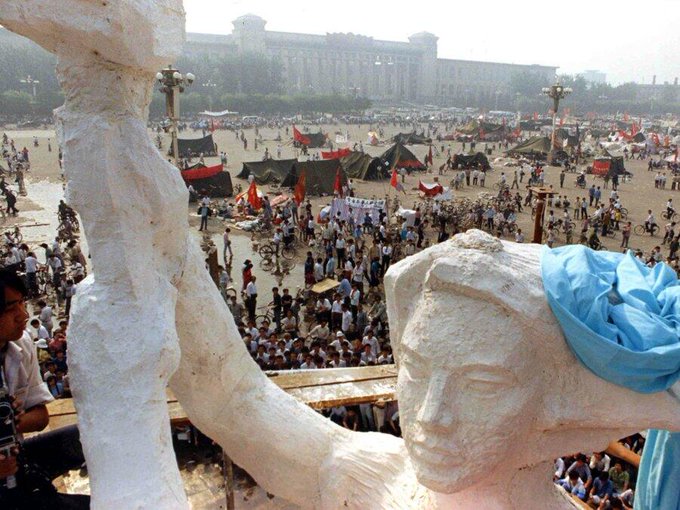
May 30, 1989 – “But as the symbol of the people’s hearts, she is divine and inviolate.”
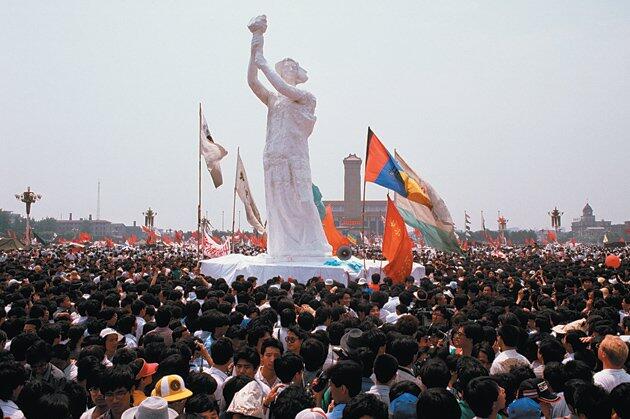
May 30, 1989 – “Let those who would sully her beware: the people will not permit this!”
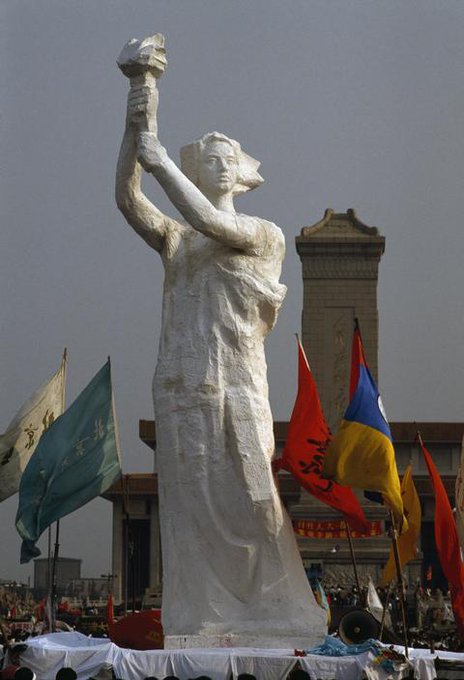
May 30, 1989 – “On the day when real democracy and freedom come to China, we must erect another Goddess of Democracy”.
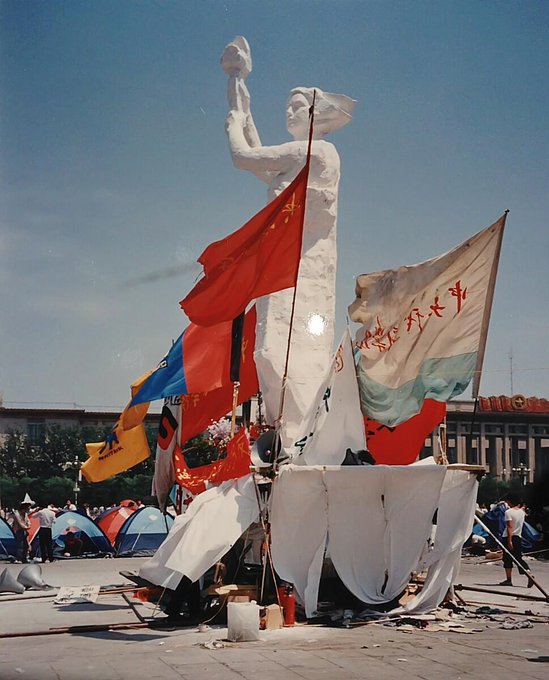
May 30, 1989 – “…here in the Square, monumental, towering, and permanent.”
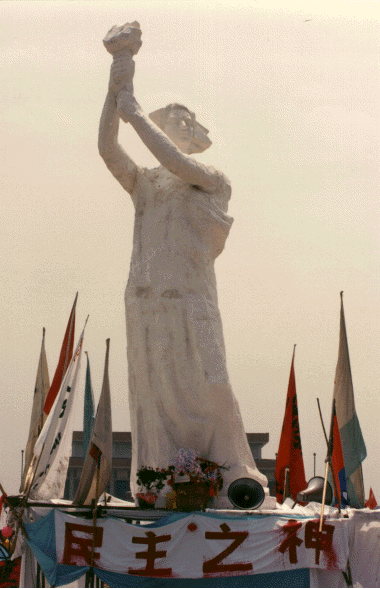
May 30, 1989 – “Chinese people, arise! Erect the statue of the Goddess of Democracy in your millions of hearts!”
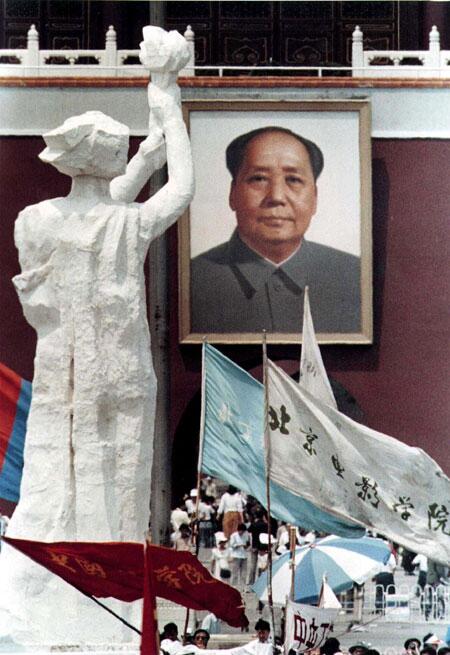
May 30, 1989 – New York Times: “In Beijing shouting match, students are overpowered.”
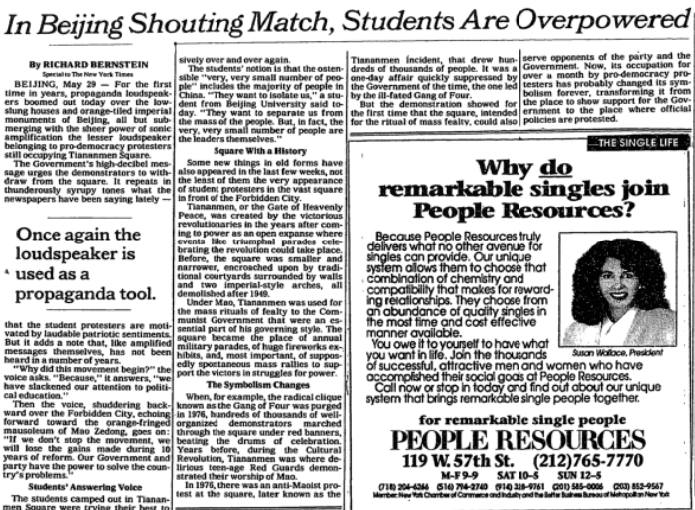
May 30, 1989 – Beijing cake-seller tells New York Times: “The students and citizens are tired … We are exhausted and we are disillusioned.”
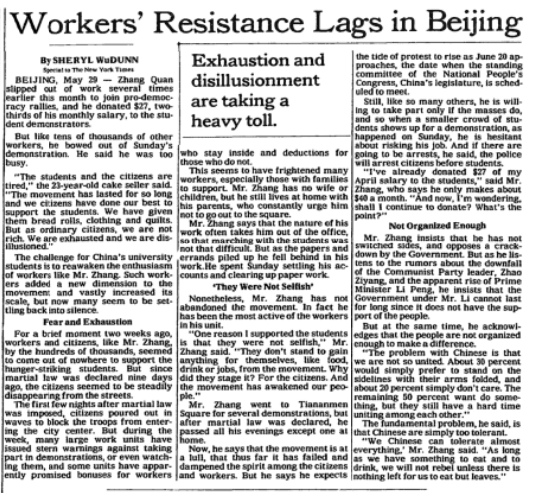
May 30, 1989 – Full page ad in New York Times.
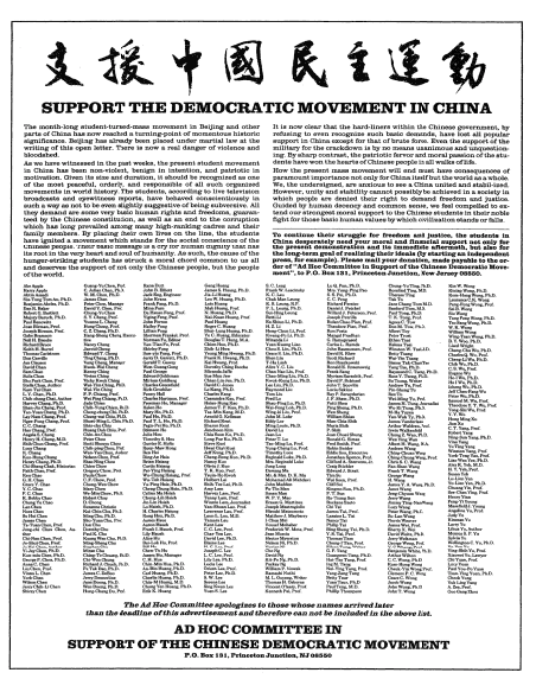
May 30, 1989 – People’s Daily: “The Square is sacred. No one should have the right to add any permanent memorial.”
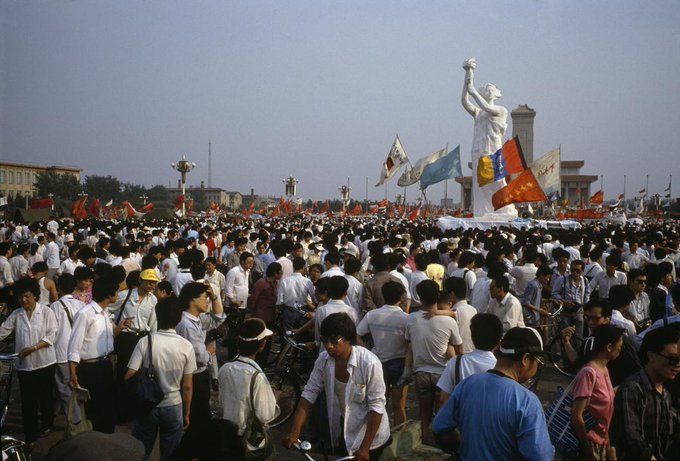
May 30, 1989 – Government loudspeaker: “Your movement is bound to fail. It is foreign. This is China, not the US.”
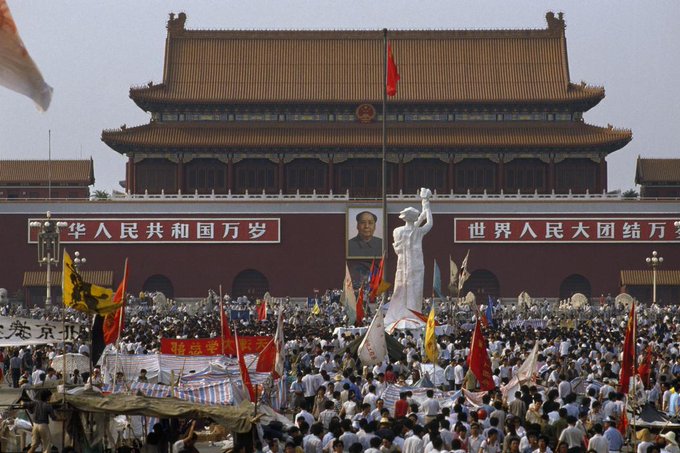
The story continues here in Part 4: Clear the Square.
[…] The story continues here in Part 3: Attempts to Impose Martial Law […]